Camogli, italy
“When in Milan, go to Camogli”, at least that’s what the Milanesi will tell you. This old pastel colored fishing village - located on the west side of the peninsula of Portofino - might just be the perfect weekend getaway for any-style explorer. Take Me Away asked photographer and storyteller Colin Clark to share his recent trip to Camogli, unquestionably now a “must-go-to” destination.
Here’s Colin’s TAKE on the perfect weekend trip to Camogli. . .

I went to Italy to photograph a five-star bicycle tour leading a group of riders from the Adriatic to the Mediterranean, through Umbria and Tuscany. I followed along in a 5-speed Ford Focus, driving like the mad Italians I passed on the windy hillsides, as I followed the group on the back roads, chasing them and shooting them as they sped past in their pelaton, banking around turns. The tour ended in Pisa, and after an afternoon taking photos of silly tourists holding up the Tower - and having to part with my beloved Focus - I took a train to see my friend Alessandra in Milan. She picked me up in the morning in her little VW Polo and took me to the Italian Alps for an overnight, staying in a 17th century boarding house in a tiny town called Alpi Devro, and hiking in the foothills. The mountains were breathtaking but cold! I didn’t have the right clothing. So, when we got back to the city with five more days before having to return to New York, and with no real desire to stay in Milan, I decided to head to the Ligurian Sea. I had been to Cinque Terre when I was just out of college, and remembered the beauty of the olive orchards built into the hillside, and the paths winding up and down connecting the five towns along the coast. I thought this would be an ideal way to spend my remaining days. Alessandra told me no, best to avoid this touristy place full of Americans and Germans. Italians, she said, when we go to Liguria, we go to Camogli.
Camogli is a sleepy fishing village south of Genoa and north of Portofino, on the Portofino peninsula and the Gulf of Paradise, as it’s aptly named. The name of the town is derived from “Casse Delle Mogli” - house of wives - for the women who would watch over the town while their husbands were at sea.
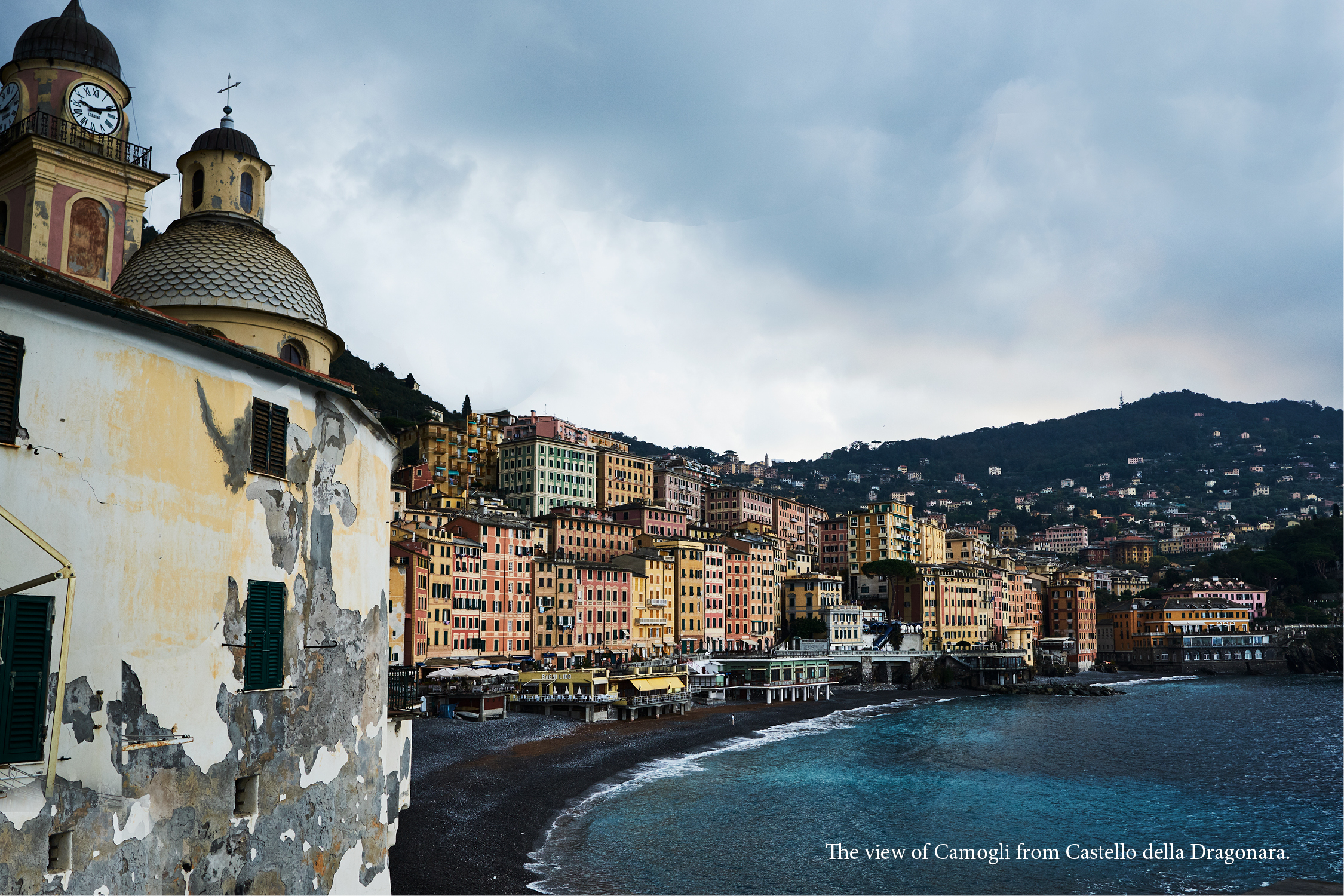
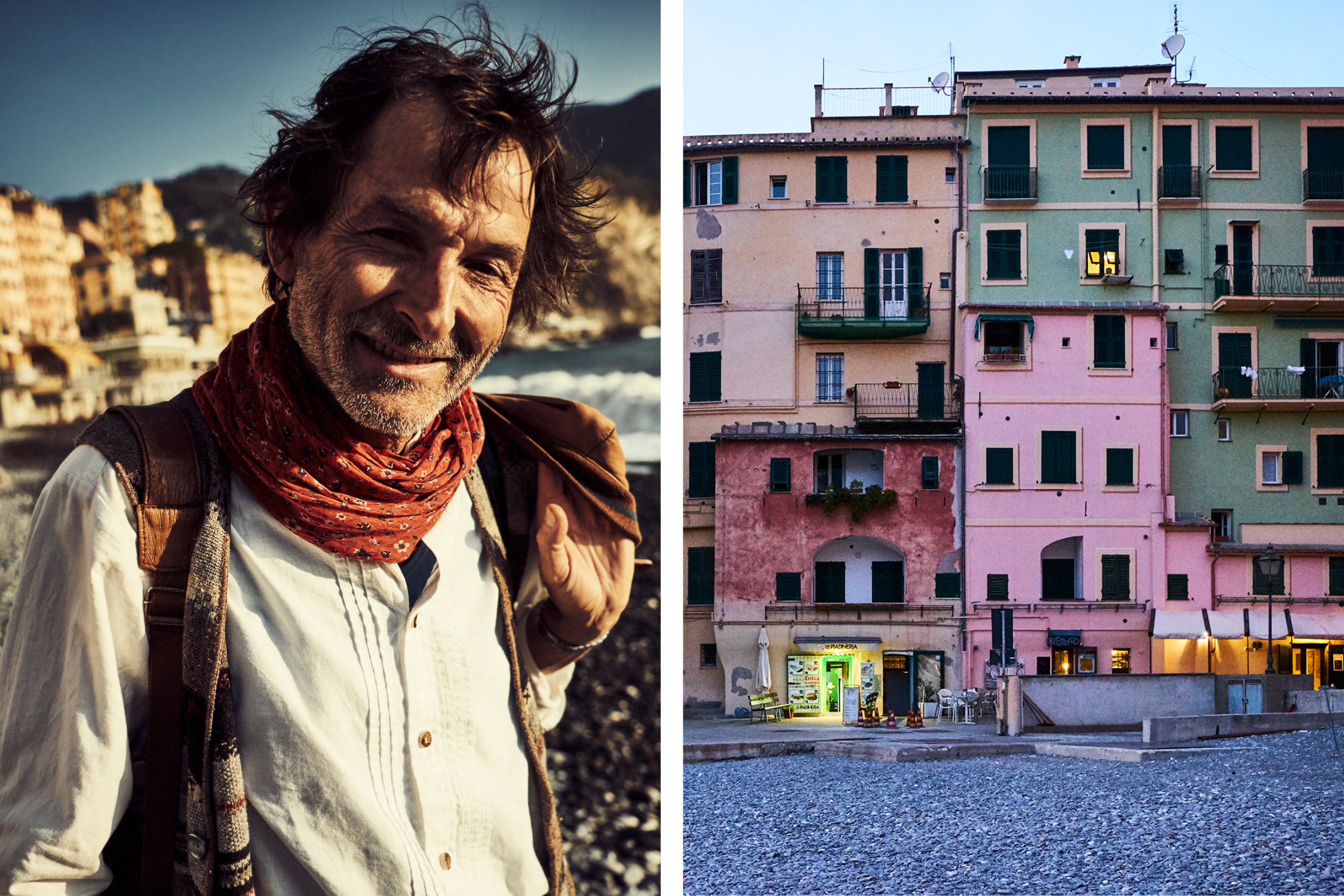
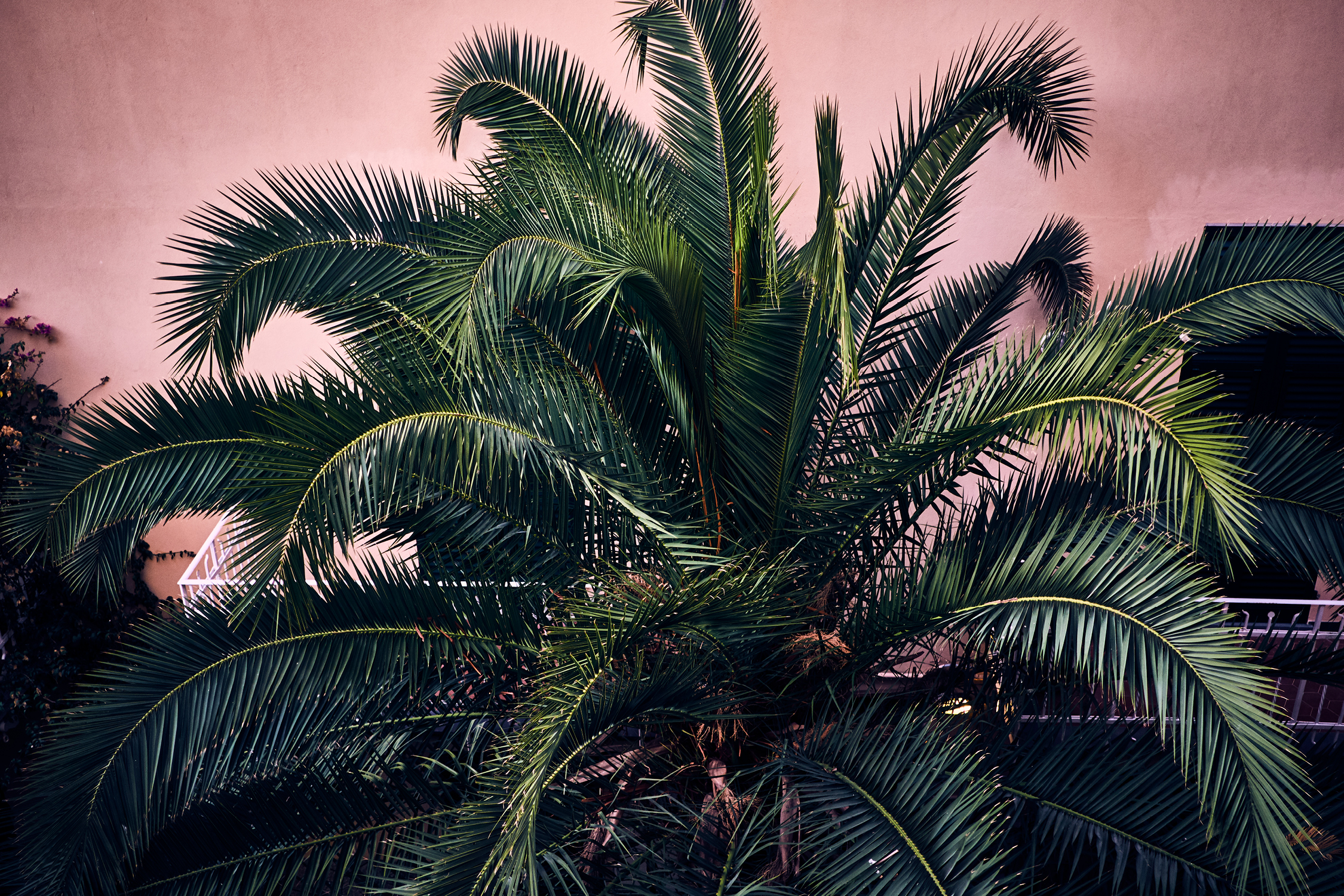

I hopped on a train from Milan’s central station and in very little time was staring out the window onto a coastline of jasmine and laurel, olive trees, and clay tiled roofs built into the steppe below the train tracks. I hadn’t planned anything, typical of me. I tend to leave most everything to chance. I did however manage to book a room in an Airbnb - the top floor of a Russian woman’s apartment which, she boasted, was in all of the town, the closest to the sea. It was in fact so close I could have fished out the window.
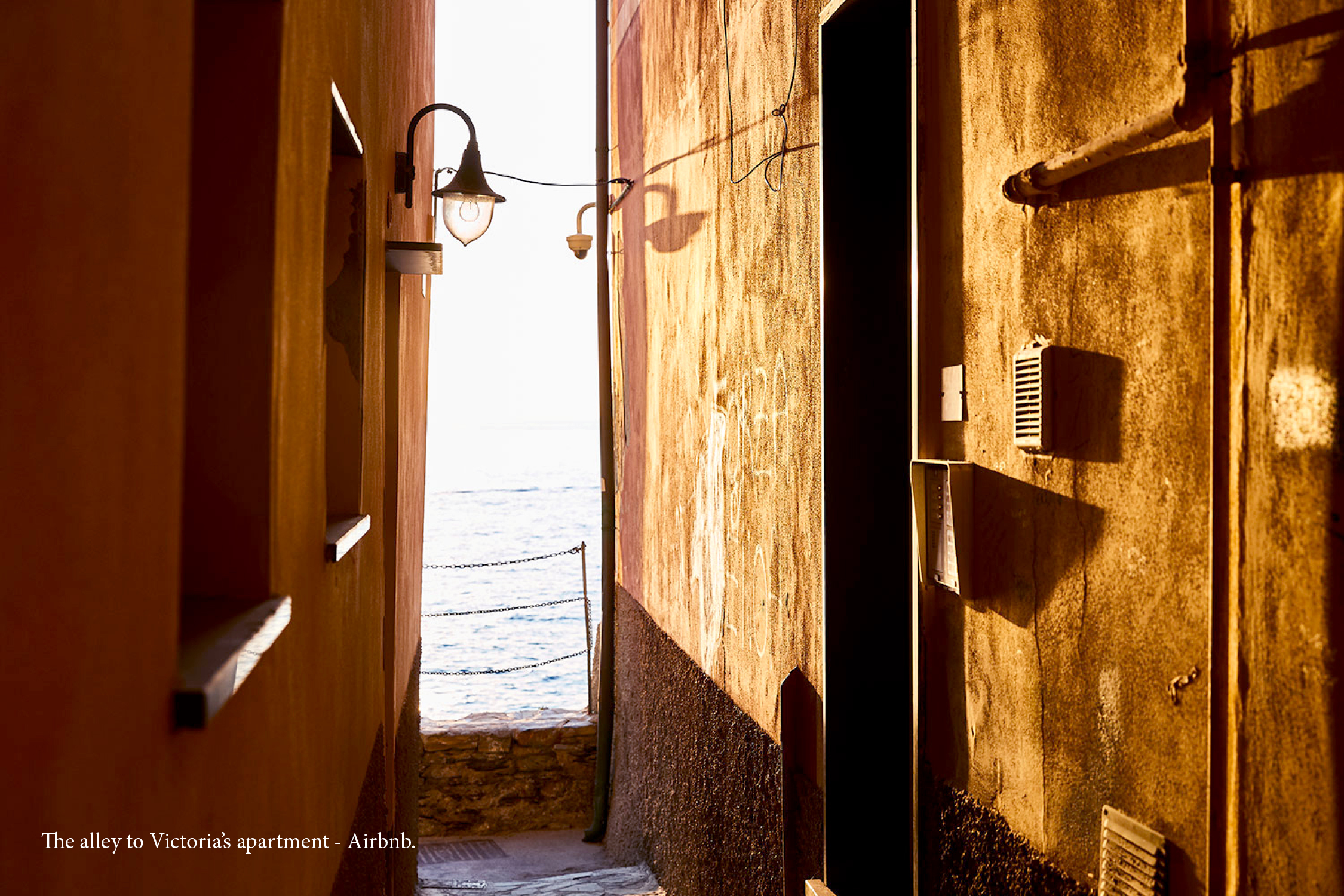
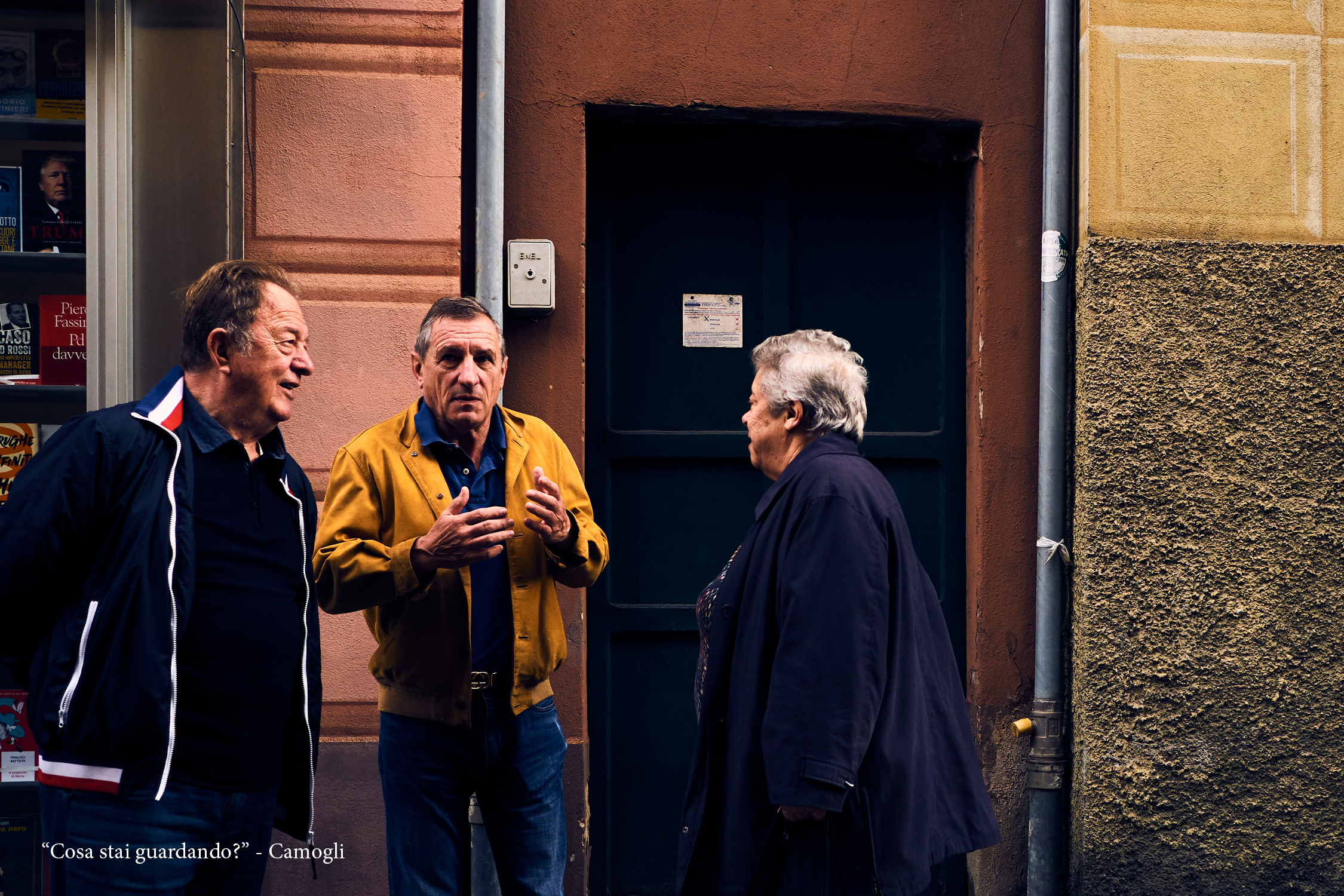
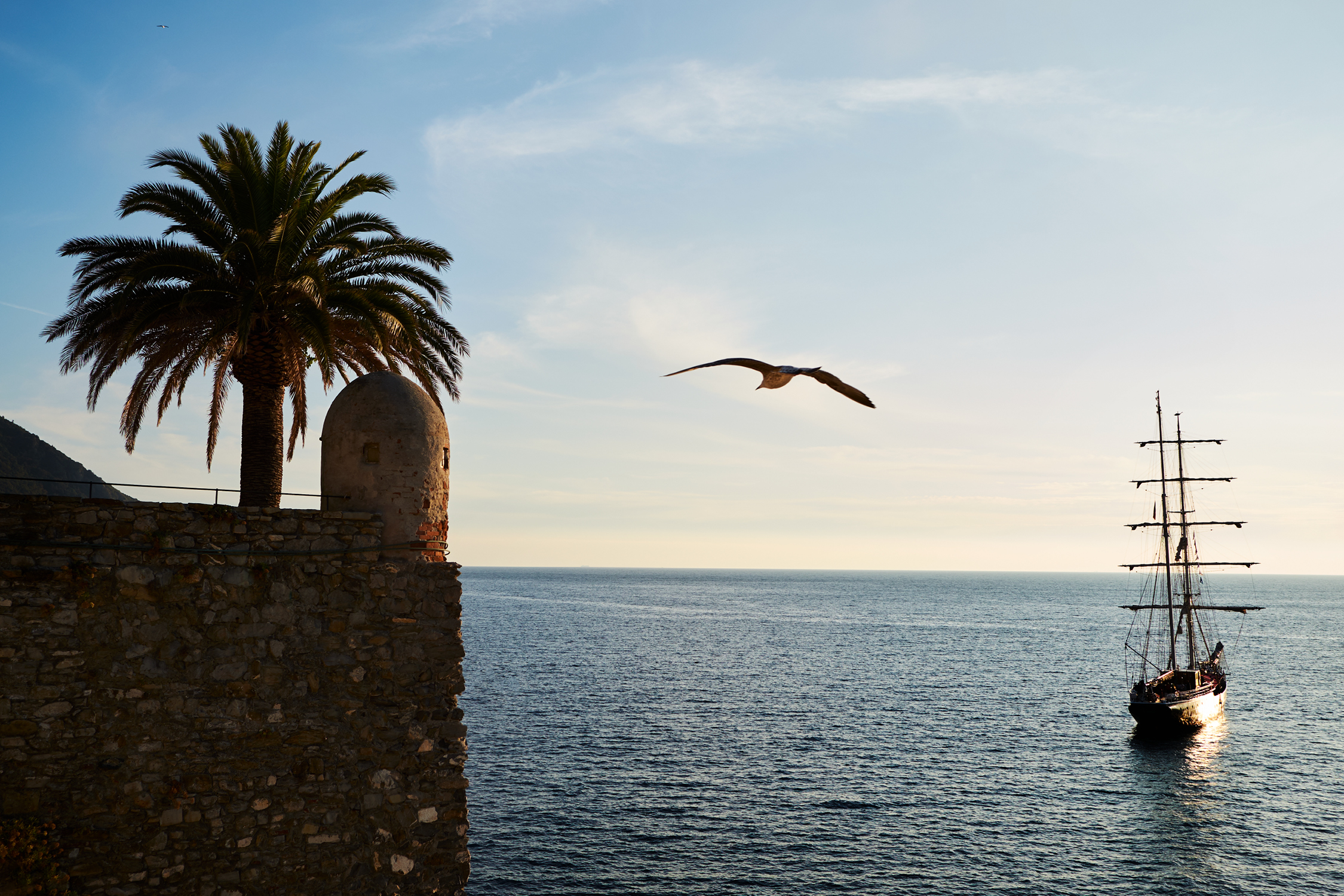
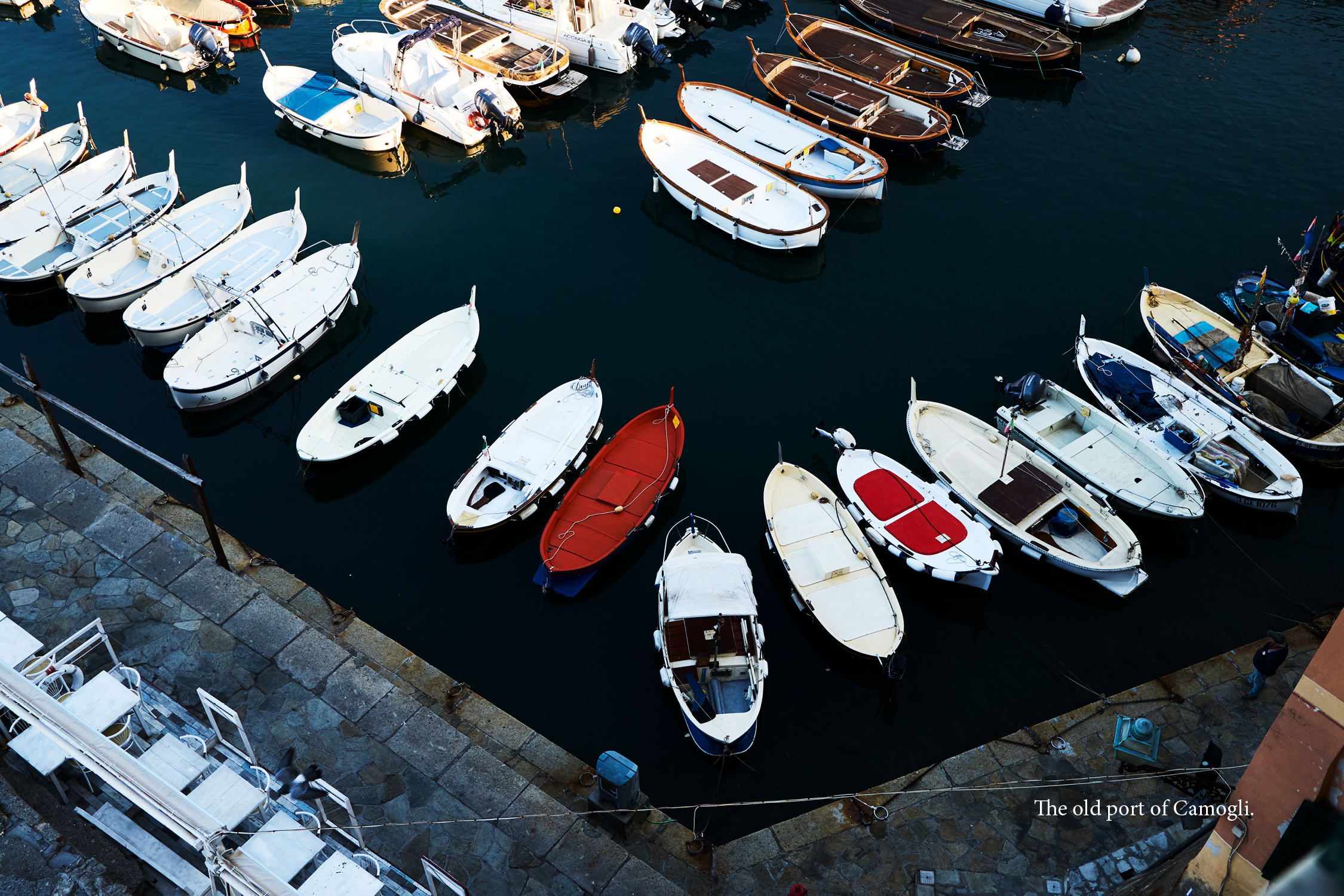
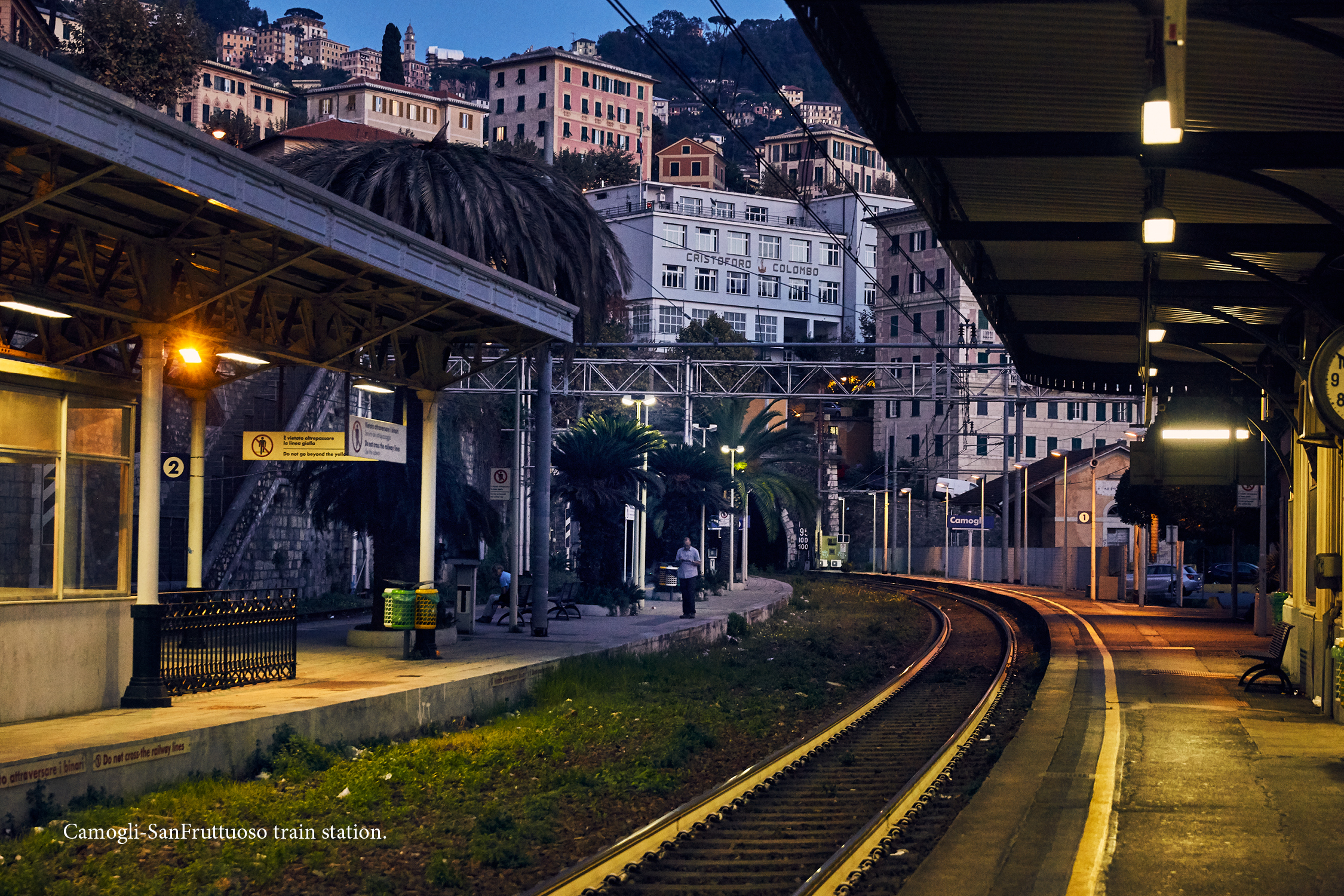
Getting off the train I was struck by the afternoon light against the terracotta facades, the multi-story palazzi, stacked so tightly on the steep hillside, bathed in an earthy orange glow. Stairs led down from the train station to the main street at such a sharp angle I thought no wonder Americans don’t come here. I took this past cafes, and bakeries, a smoke shop and fish store, and followed it down another set of stairs to the promenade along the shore to the end where an ancient Gothic church with a spire was built onto the rocks. An alleyway led me to another staircase and up to a small square and the entrance of the bell tower, then down the other side, through another alley literally to the shoreline. My host, Victoria, gave me very specific directions on how to find her building, thank God, otherwise I’d have been totally lost. But here it was, and lo and behold here she was too, having timed my arrival quite perfectly. She led me up five flights to her cute and sparse apartment. I took a quick inventory of the place: everything was white, white table, white couch, white walls, a few shells and books on a shelf, some framed impressionist prints of paintings on the floor leaning against the wall, a piano in one corner. Victoria was quite pretty but she seemed lonely, held my gaze a tad too long. Told me she bought the place with her mom and moved here from Milan after realizing a life modeling was too superficial. She said I could help myself to anything in the fridge and pointed me to my room one more flight up. The window overlooked the sea and opened like a hatch. I laid down for a moment to close my eyes and listen to the tide, but then sprung-to for fear of falling asleep. I wanted to take part in that glorious evening light, walk around with my camera, see what I could see.
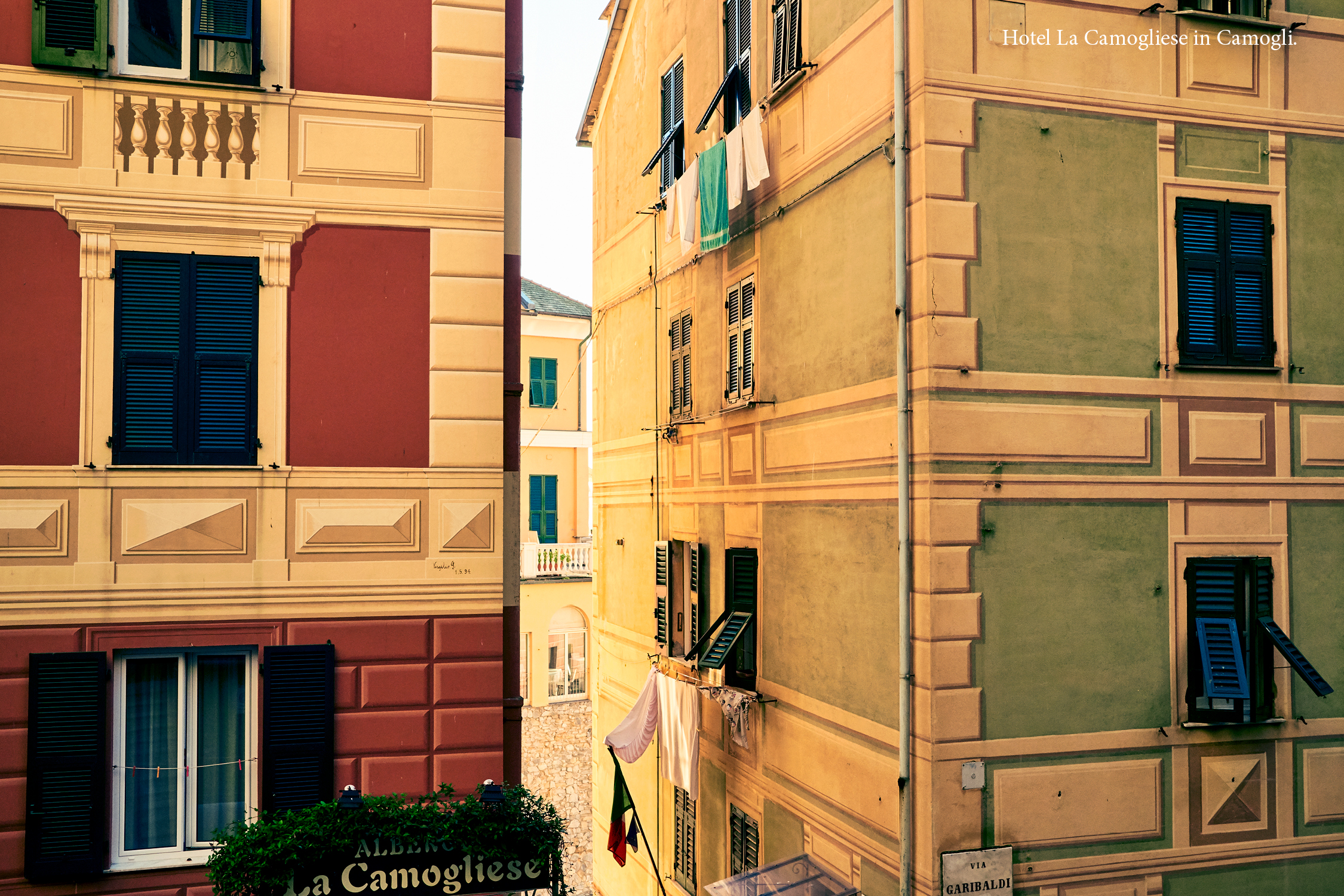
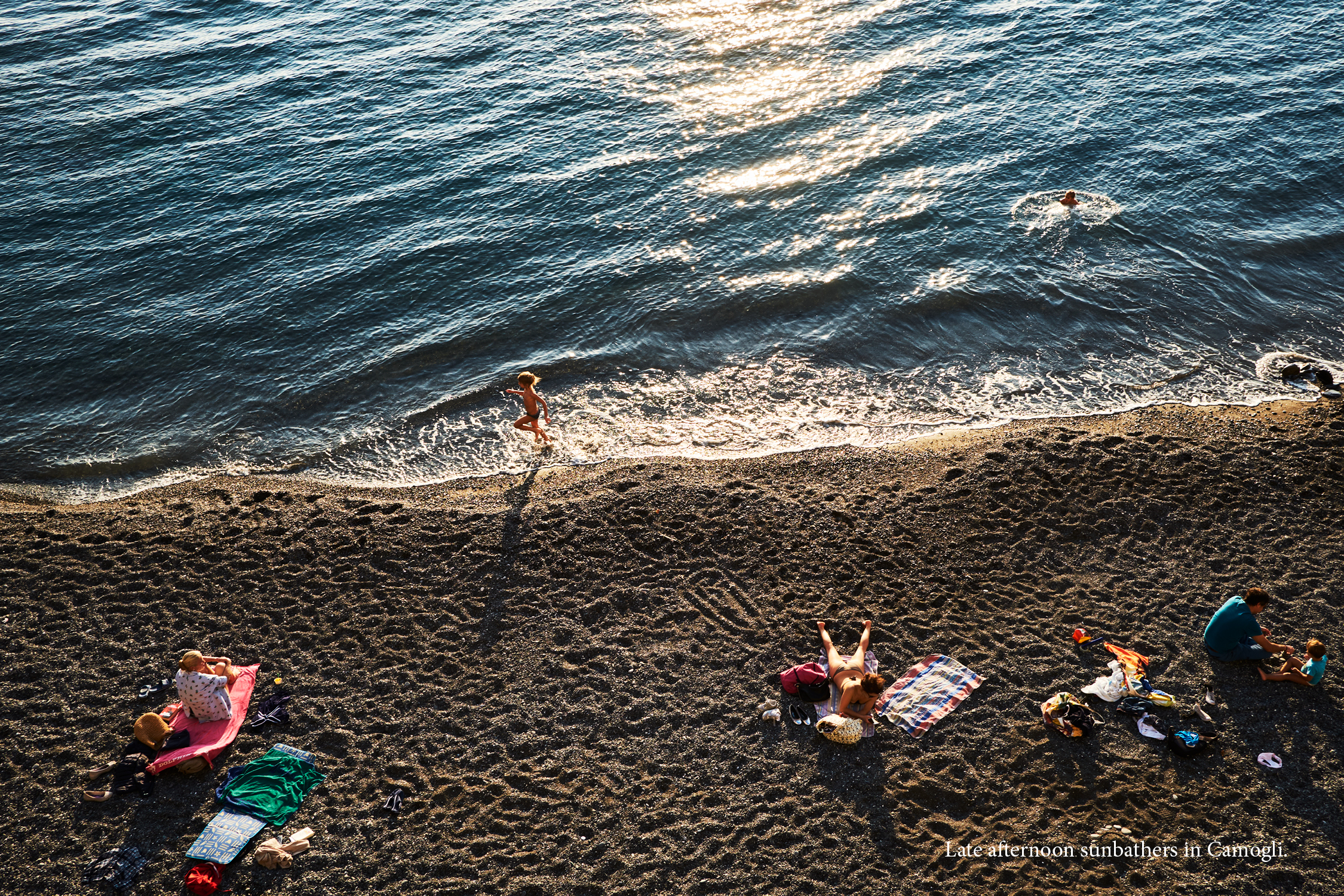
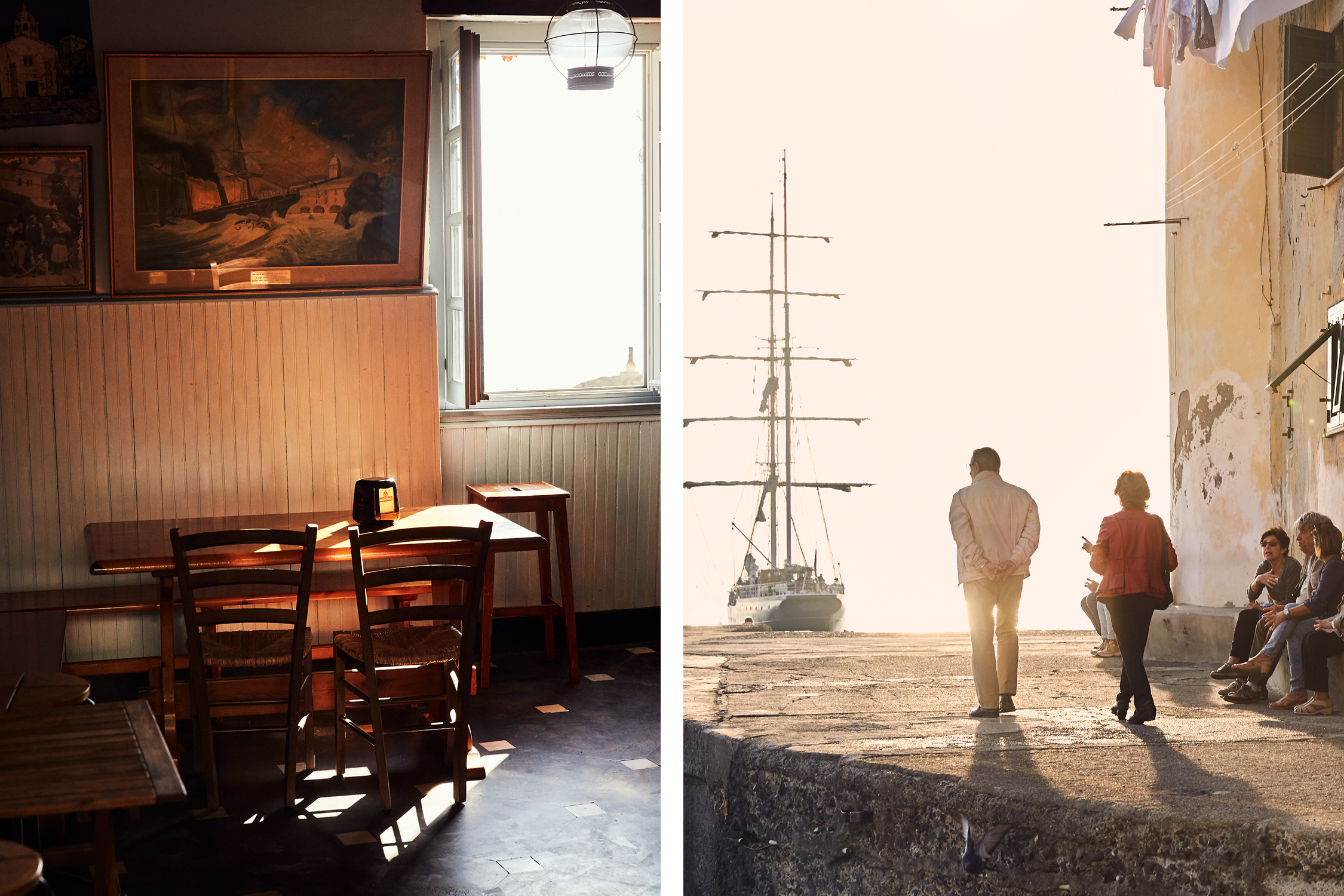
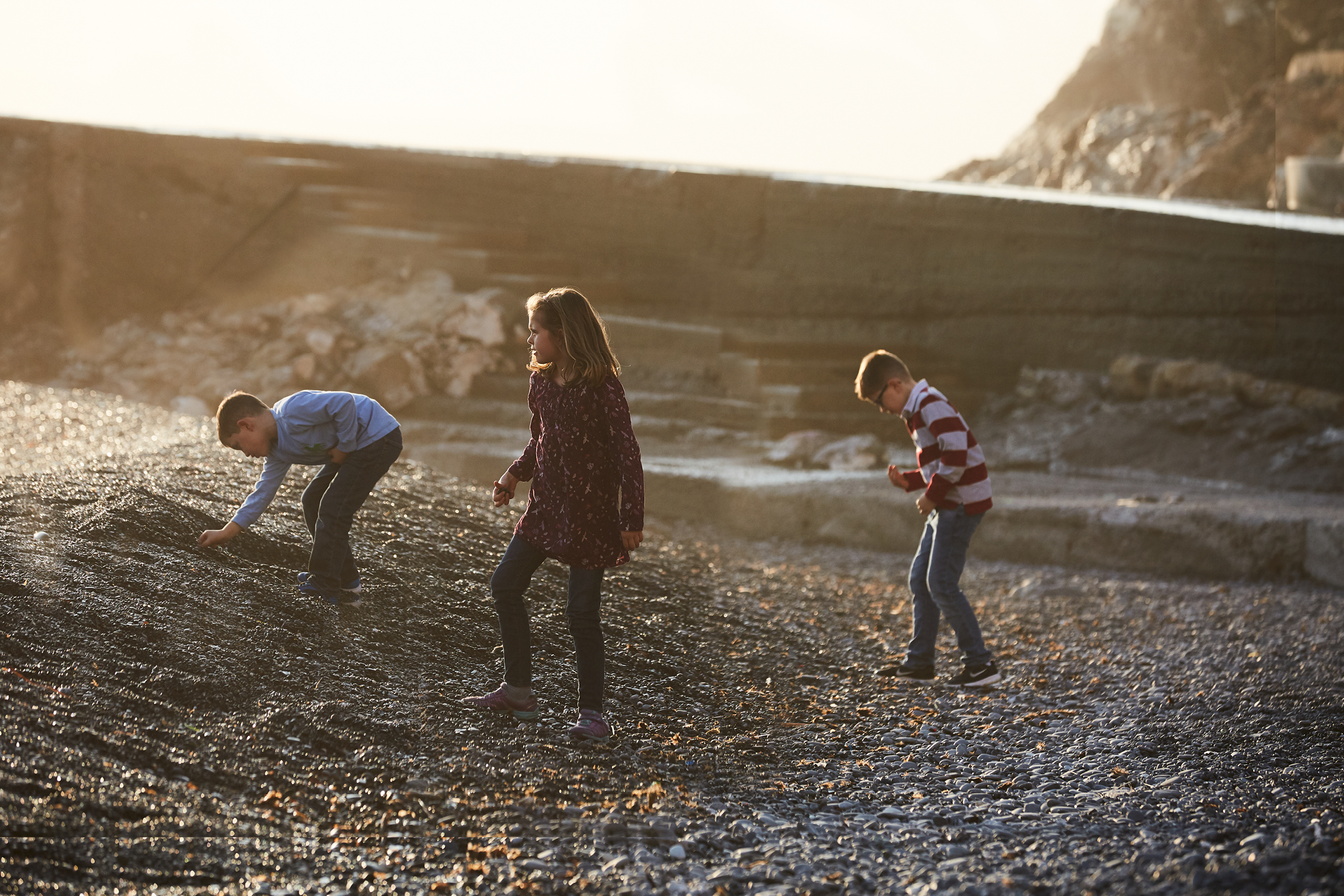
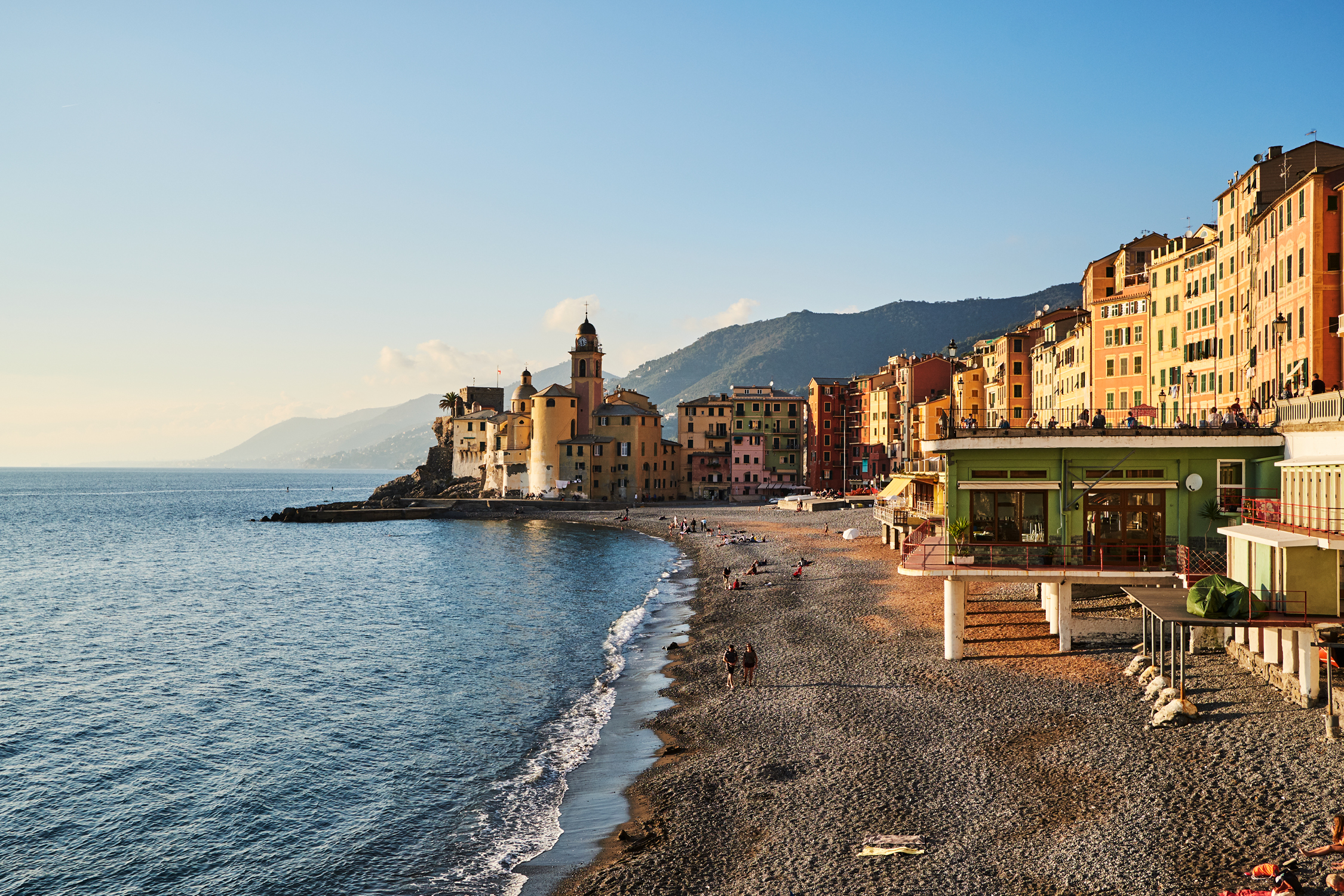
There’s something so comforting to me about being by the Mediterranean. Instantly I could feel that Camogli was my kind of “beach town”, quiet and colorful, away from the fray and anything resembling hipness. No surfers, no yoga retreats, no club kids. It felt like a place to come and spend a month to write a memoir. Alessandra told me it’s famous for focaccia so the first thing I did was search out a few slices of focaccia pizza, my fave. Revello is the spot, heard on the street, and it wasn’t hard to find: there was a small line out front, folks waiting for the next just-out-of-oven batch. The bread was soft and airy, the perfect amount of salt. The tomato sauce, seasoned only with fresh oregano, was layered thinly under fresh mozzarella. It tasted like heaven. I took out two slices and sat on the rocky beach, noticing right away the sound of the water raking across the tiny rounded pebbles as it sifted back to sea, the rhythm of that almost orchestral sound, so different from waves crashing on a sandy beach.
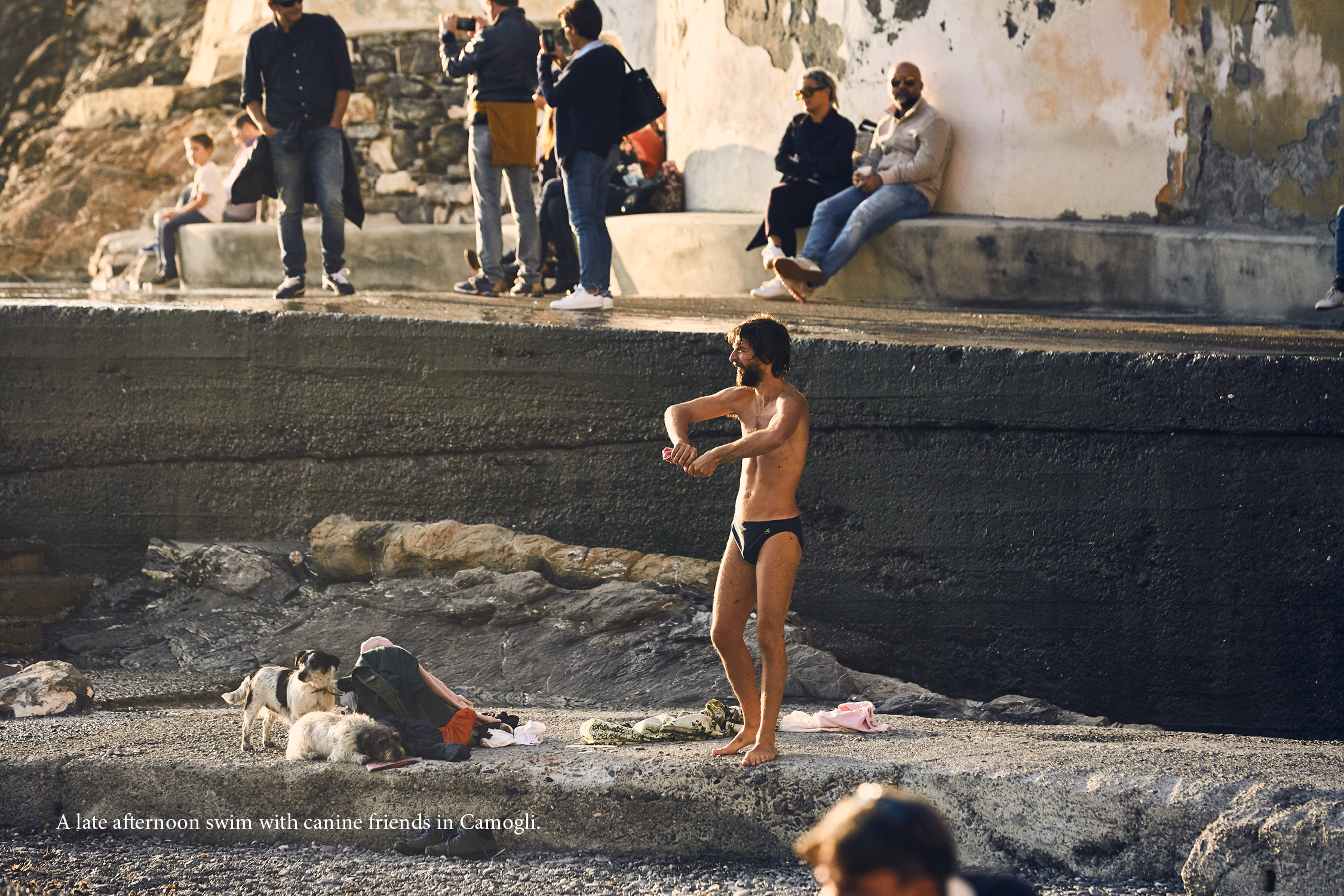
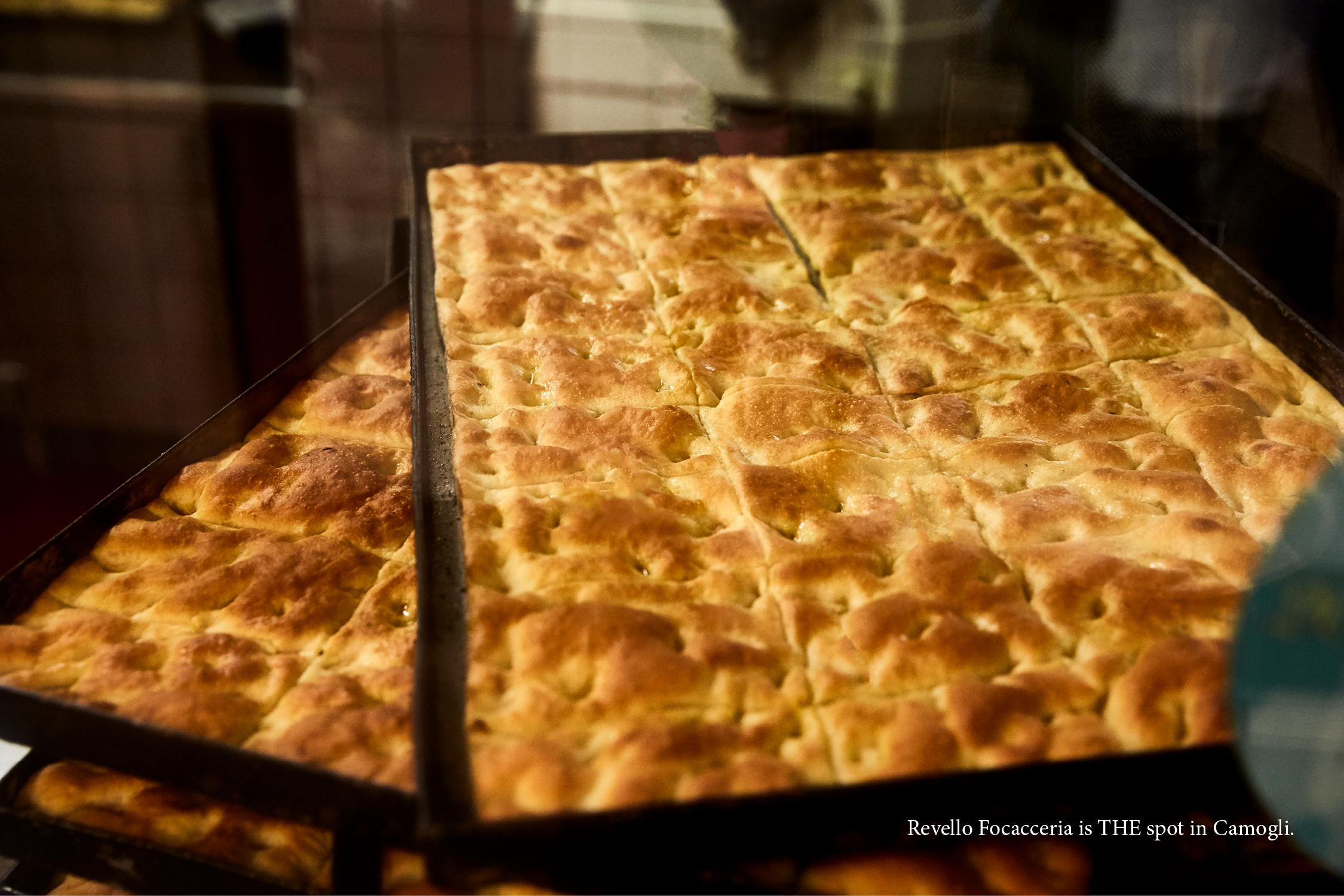
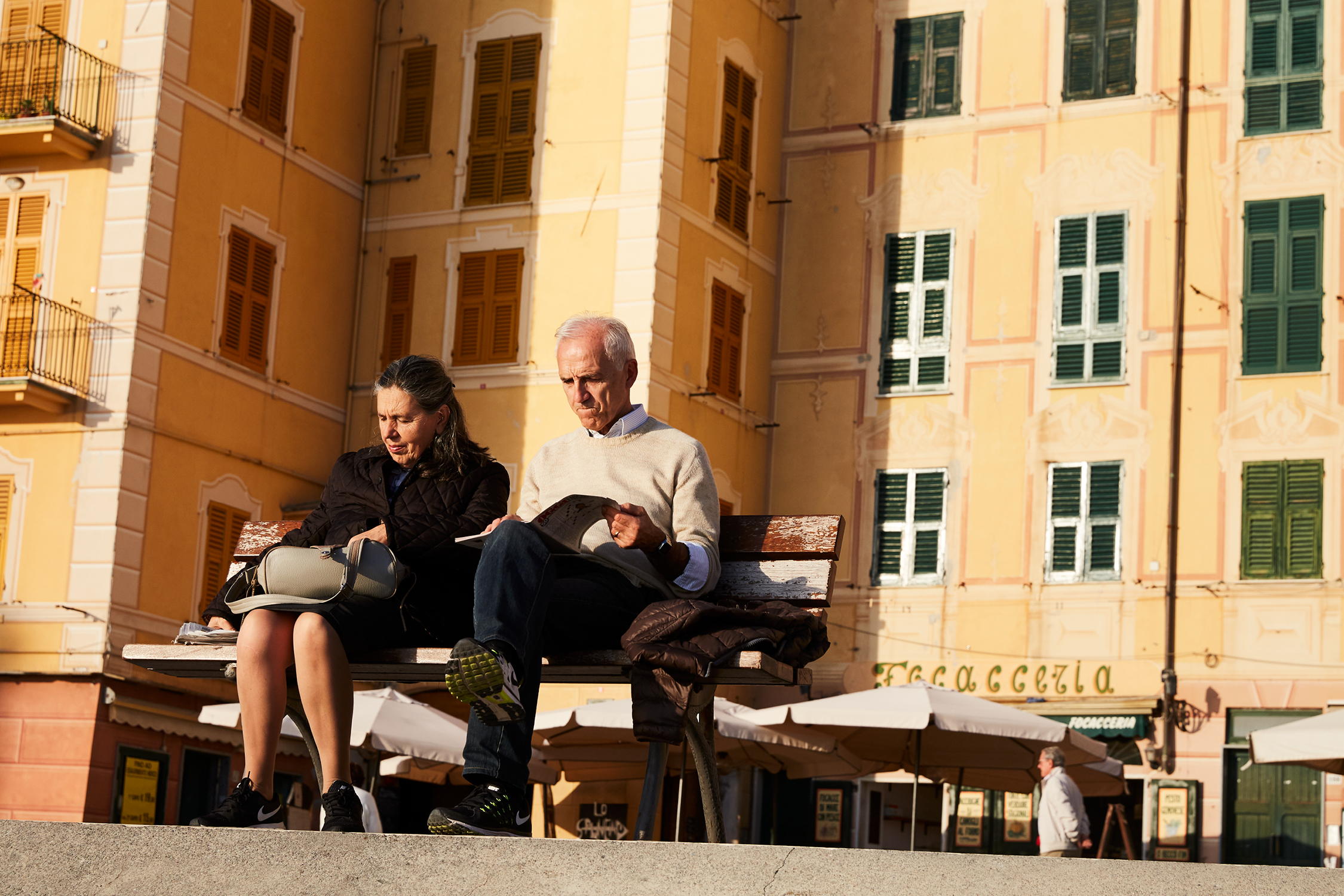
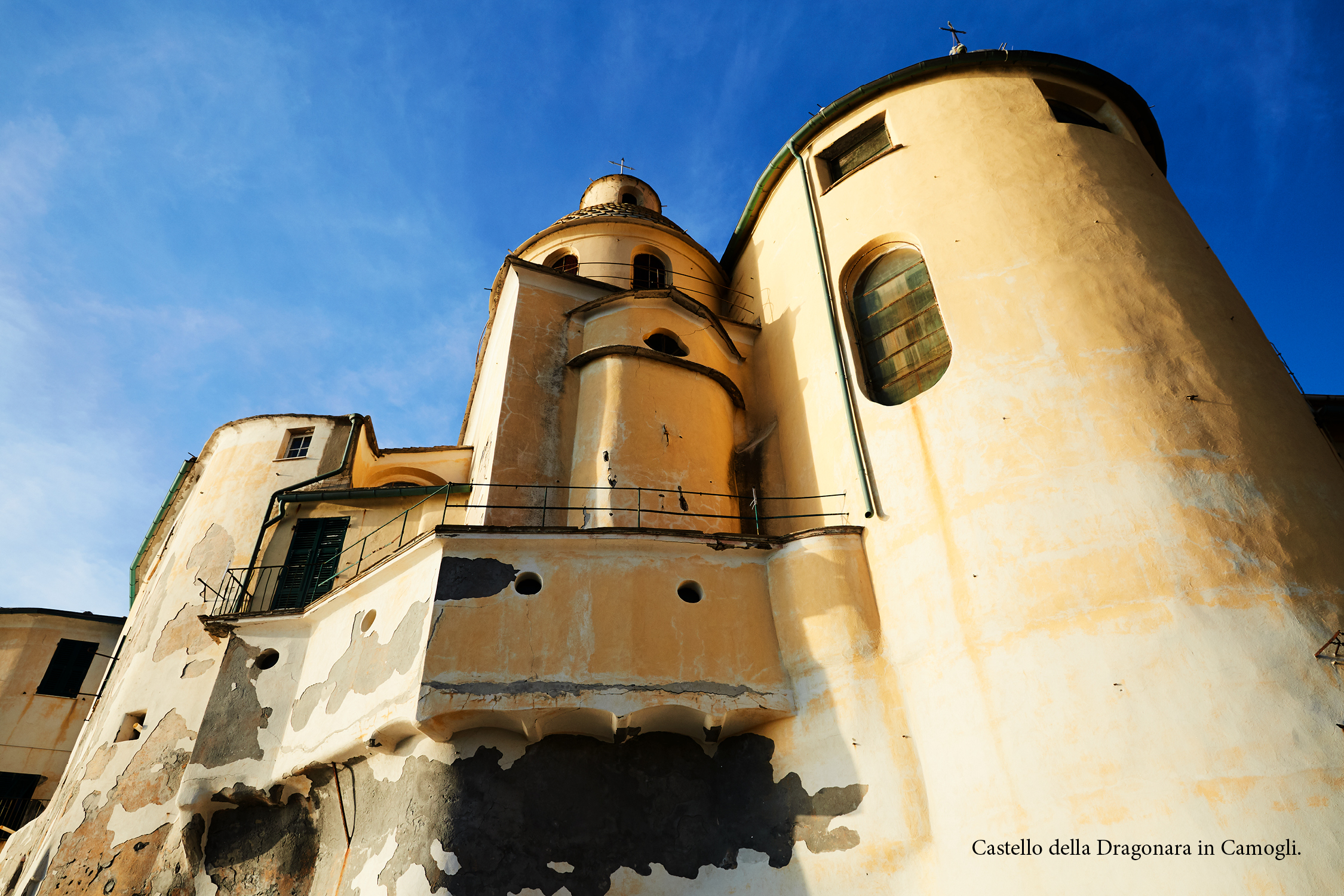
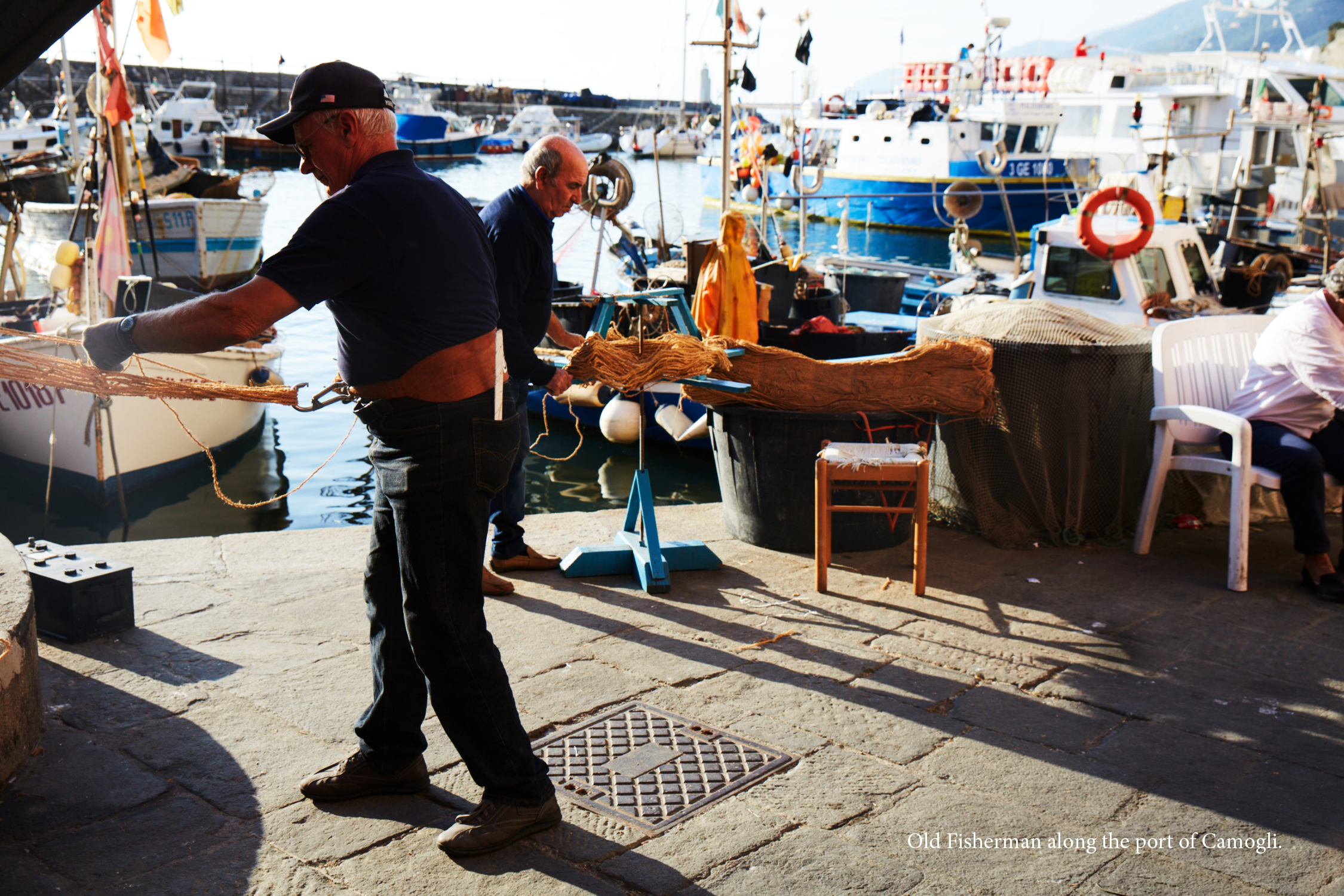
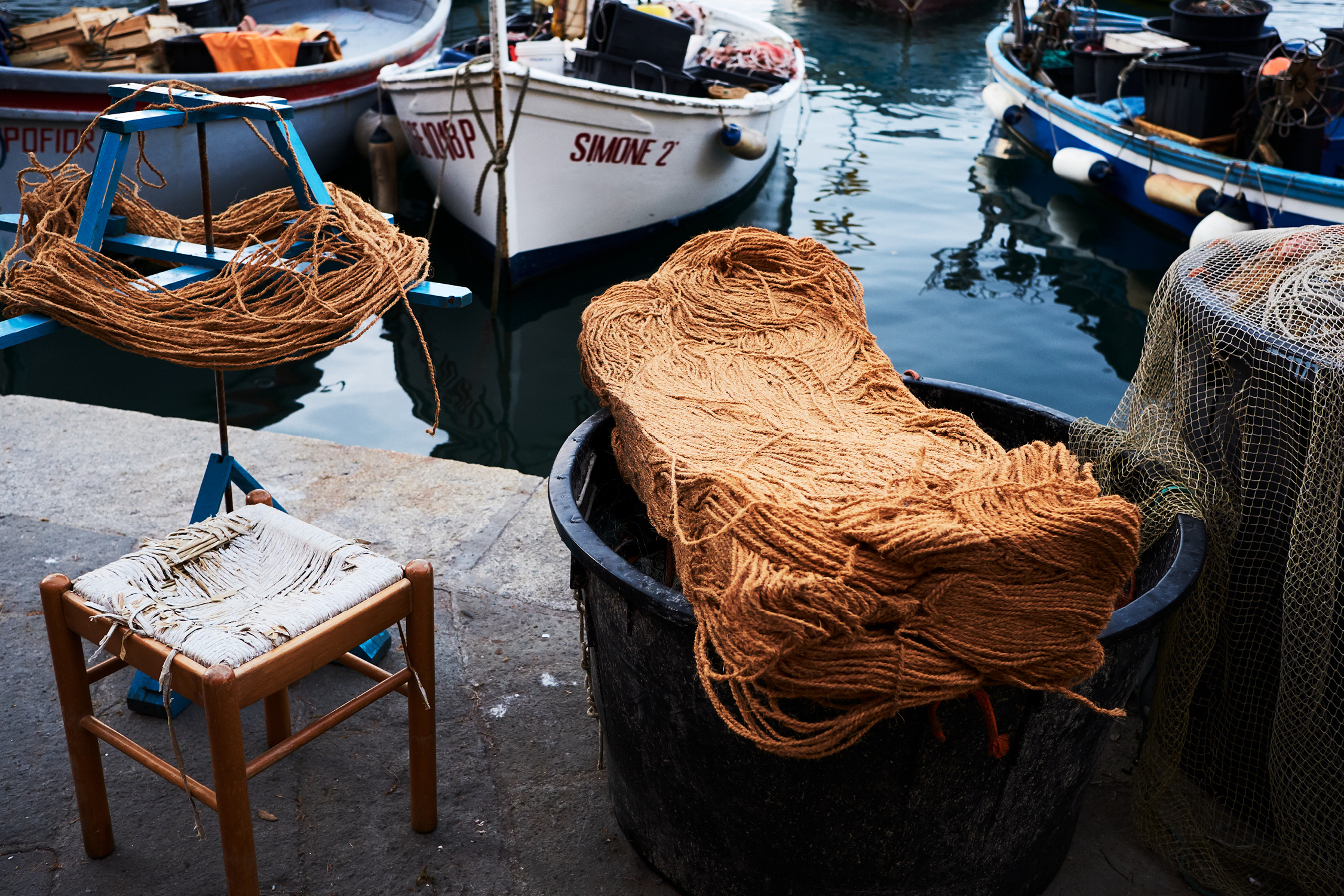
I walked south, past late-day sunbathers and kids playing soccer, past gelato stores and postcard shops, heading out of town to look for the stone path Victoria told me led up into the hillside. Moving inward from the beach, I followed a road past the Carabinieri station, crossed a small stream and followed it as the pavement turned to a dirt path which wound past olive trees draped with netting. The path got steeper and steeper and soon became a stone staircase which I climbed until I got a view of the town and gulf. The sun was beginning to set, and as the light dimmed the air began to feel cool and moist on my skin. It smelled of citrus and lavender and I breathed deeply, happy to be just where I was. And then headed back into town to find dinner.
I found a restaurant called Cucu, and it was the only place I ate dinner for all four nights. I stumbled on it tucked away on a side street. Most restaurants seemed entirely to cater to the tourist crowd but this place looked more local: bright yellow walls, every inch covered with paintings and photographs, side tables stacked with photo books, a giant fish tank, jazz playing. Walking in was walking into the owners office, he sat at a big round table covered in papers and receipts, next to bulk bags of dry goods piled high since clearly there was no more room in the kitchen. He too was big and round, an affable man, who seated me at the same table every night, all the way in the back despite the place being totally empty. On the third night greeted me with a handshake and “The usual for the gentleman?” because I ordered the same meal every night: pesto lasagna - the national dish of Liguria, and fresh sardines. I loved the pesto so much I couldn’t not have it. I thought about it all day, it was the perfect balance of garlic and salt, olive oil, cheese and basil, served on ribbons of pasta, lasagna noodles, but not layered like we think of lasagna. I grilled him about his pesto and he told me it had 7 and only 7 ingredients and was a recipe passed down three generations.

In the morning after a breakfast of persimmons, coffee, and stuffed focaccia, I headed back into the hills. The stone steps led me up to the hill town of San Rocco which had a fantastic view of the sea and surrounding coastline. The entire town was built around a central church square which had cliffs on two sides. From San Rocco one can enter the Park of Portofino and hike to the beautiful and remote seaside town of San Fruttuosso, accessible only by boat or on foot. This became my daily routine. The hike from Camogli to San Fruttuosso takes about four hours and there are four different routes. The most difficult is along the cliff edge high above the sea, on the headlands. This is not for the faint of heart: there are a few spots where you absolutely must hold on to chains driven into rock, stepping very carefully along the precipice - not the preferred route for those with vertigo. (I’m a very experienced hiker and was impressed, to say the least, at the exposure and terrain traversing this route). One can also go all the way up to the top of Mt. Portofino and then slowly wind back down through chaparral and scrub oak, and then through olive and citrus groves before finally arriving up above the Gothic village of San Fruttuosso.
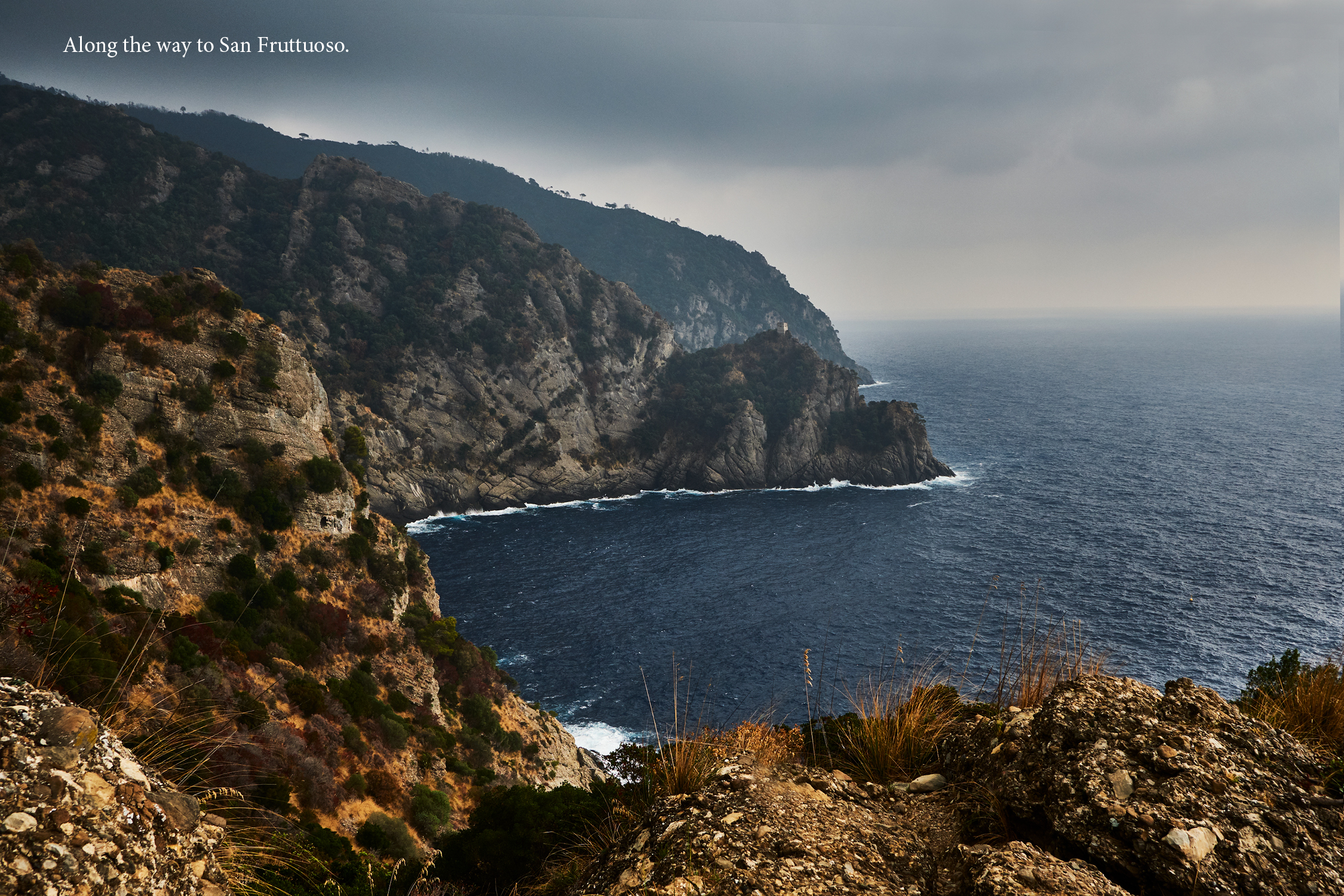
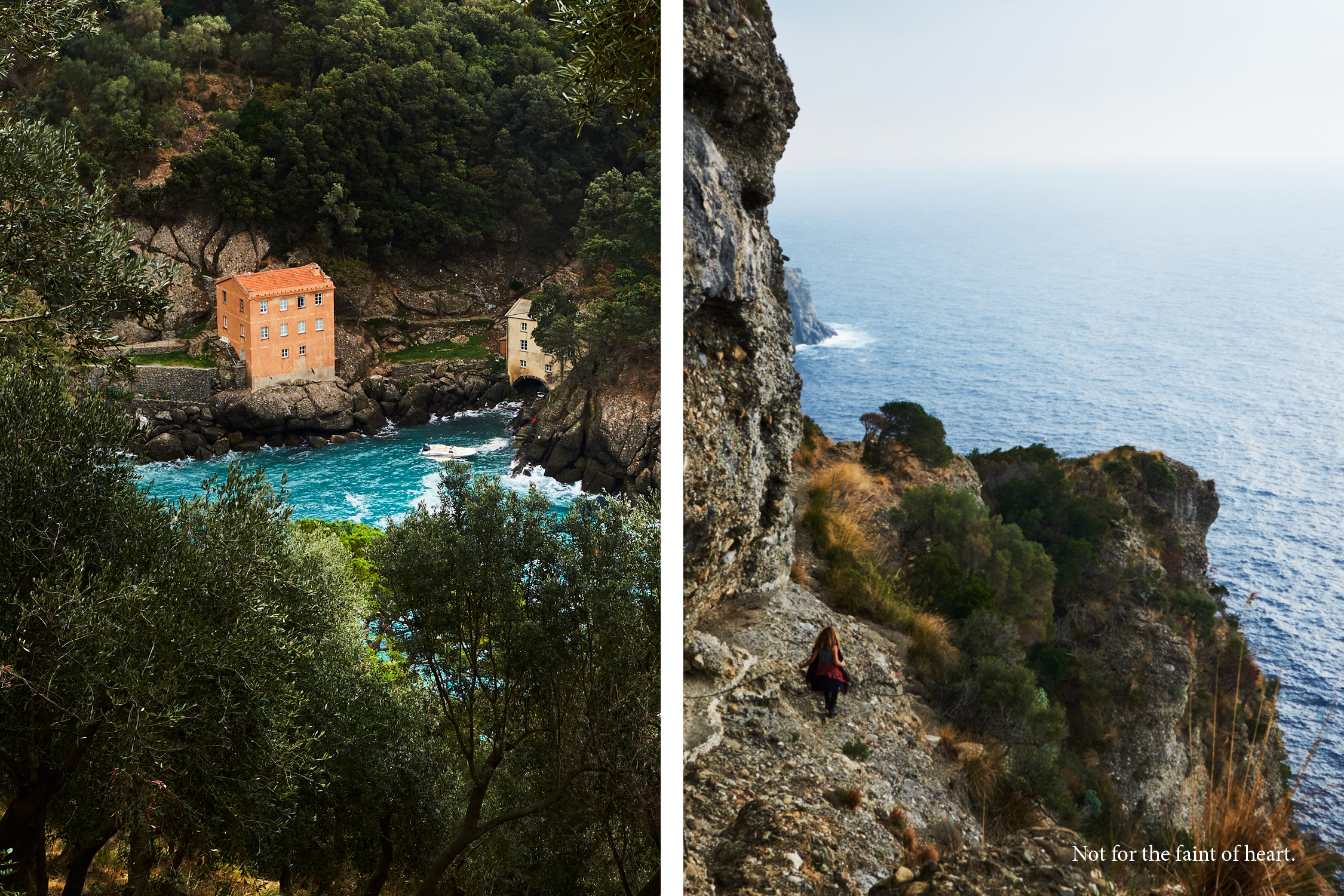
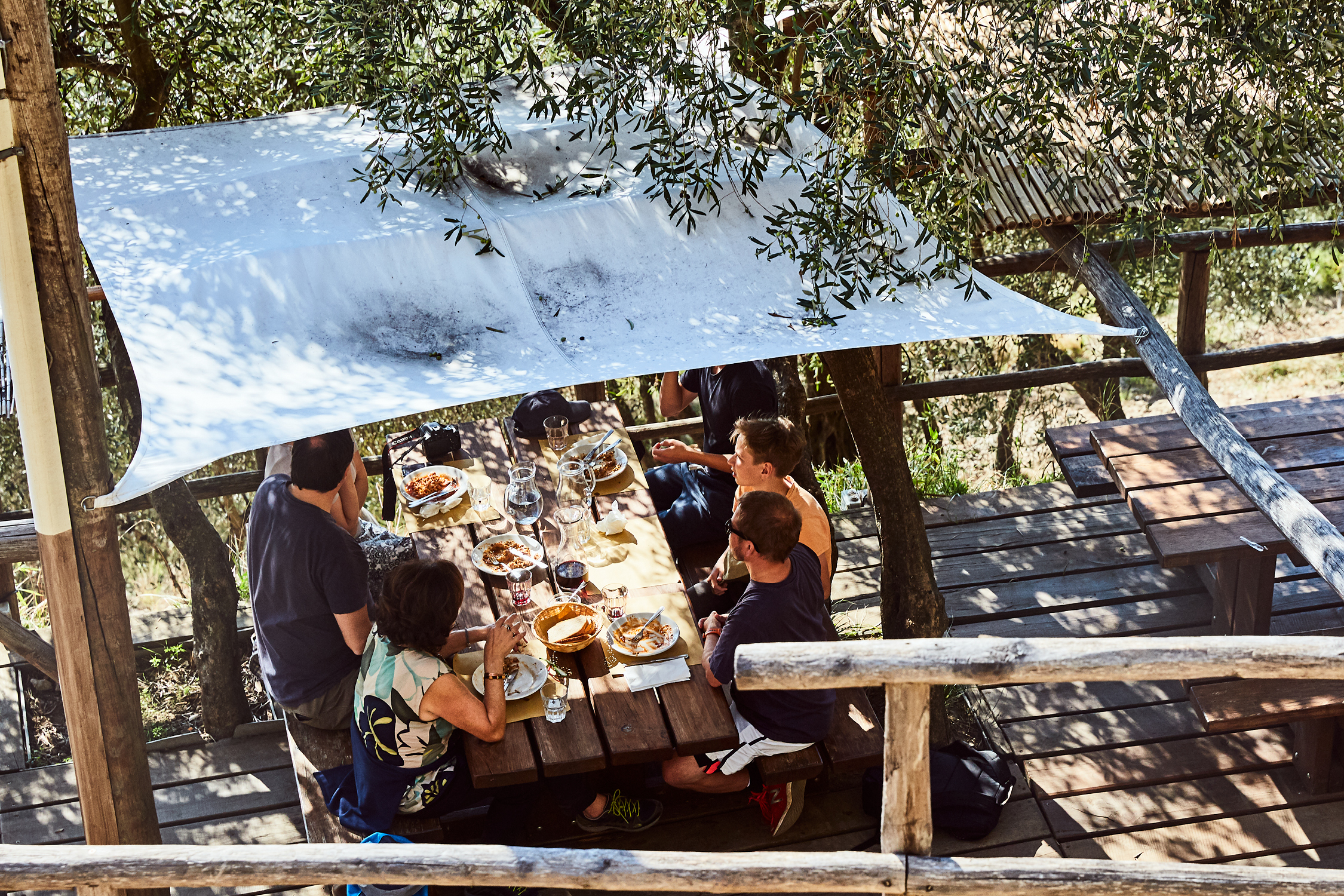
This 16th century monastery built into the cliffside, tucked into a deep narrow cove with its crystalline waters felt like a secret, timeless and removed from the outside world. I loved it here. I’d spend half the day just walking here, eat a lunch of focaccia and coffee (cappuccinos, despite getting laughed at since Italians don’t drink coffee with milk after breakfast) take a swim in the sea, and then head back to Camogli by ferry, the last ride at 4:30. I befriended this older French couple as I needed someone to watch my stuff as I swam. The gentleman seemed absolutely tickled that I was both American and a photographer. To strangers walking past he’d exclaim “Meet the American!” in a loud french guffaw. I found this very curious but gamely grinned it off. He couldn’t believe I had walked from Camogli and seemed very worried I was going to miss the ferry, keeping very accurate time for when I needed to board. It was like five yards away. But the ferry was a great bonus, sitting on the deck and getting a view of the coastline and the steep hillside I had walked, coming into the port of Camogli for the round trip experience.
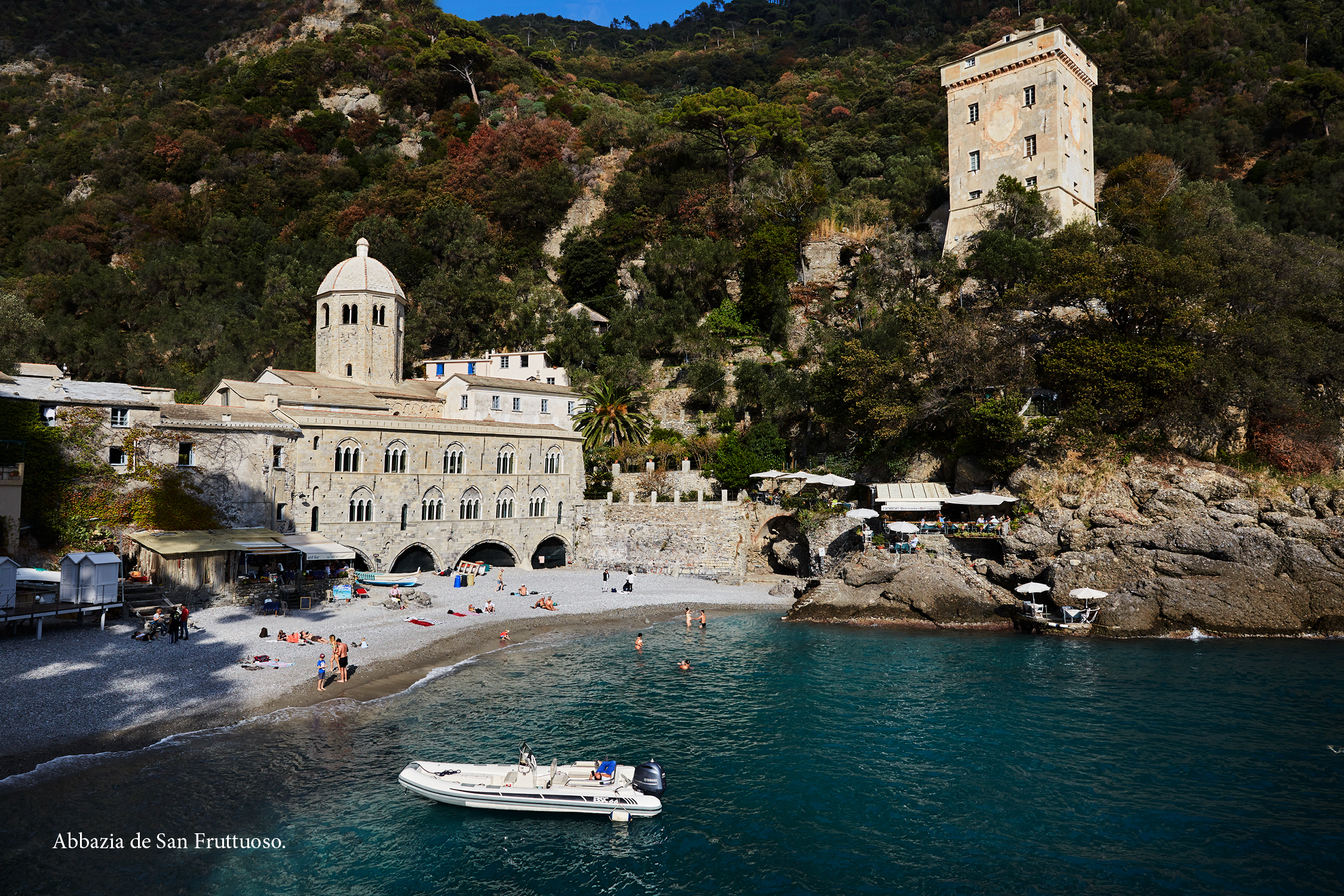


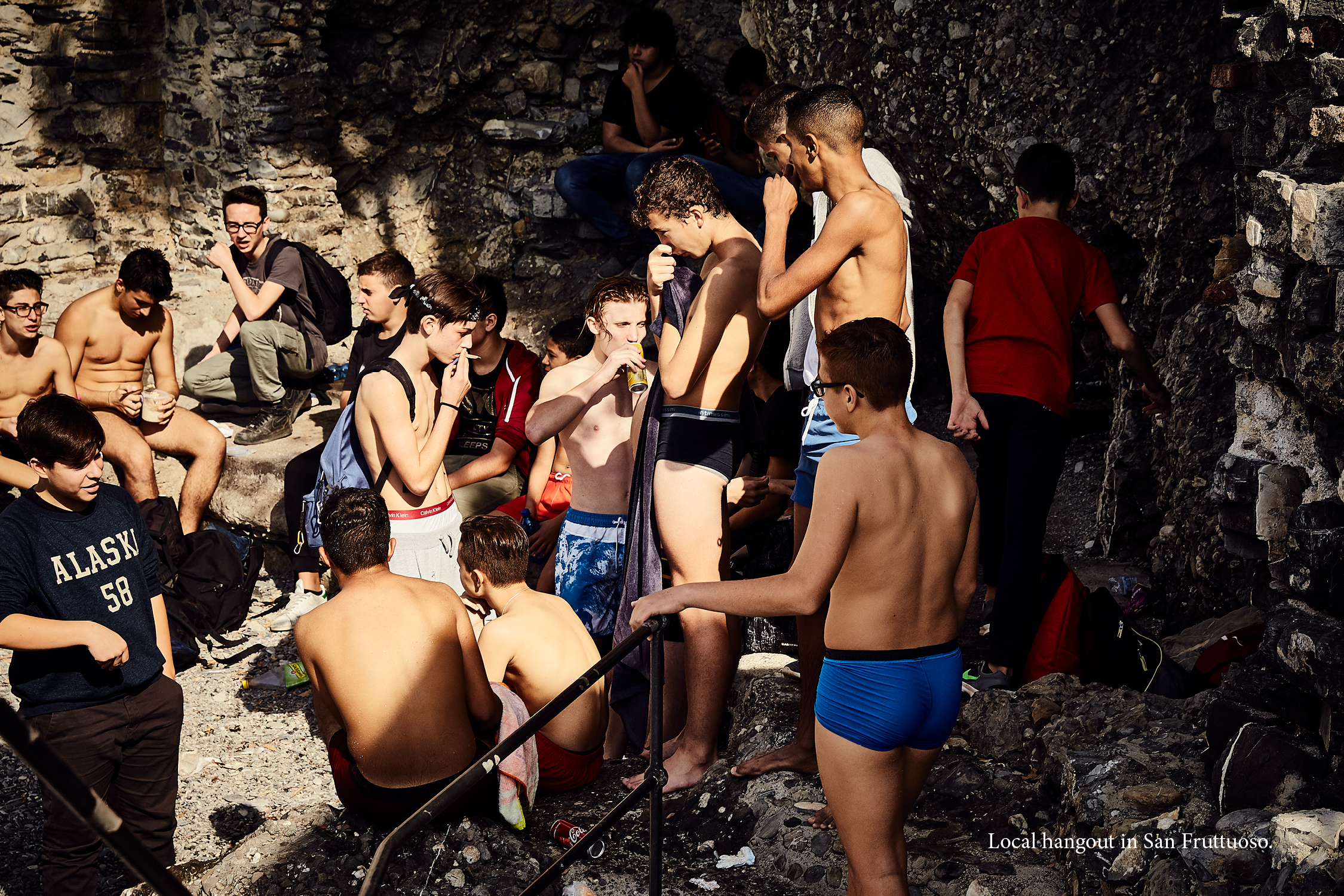
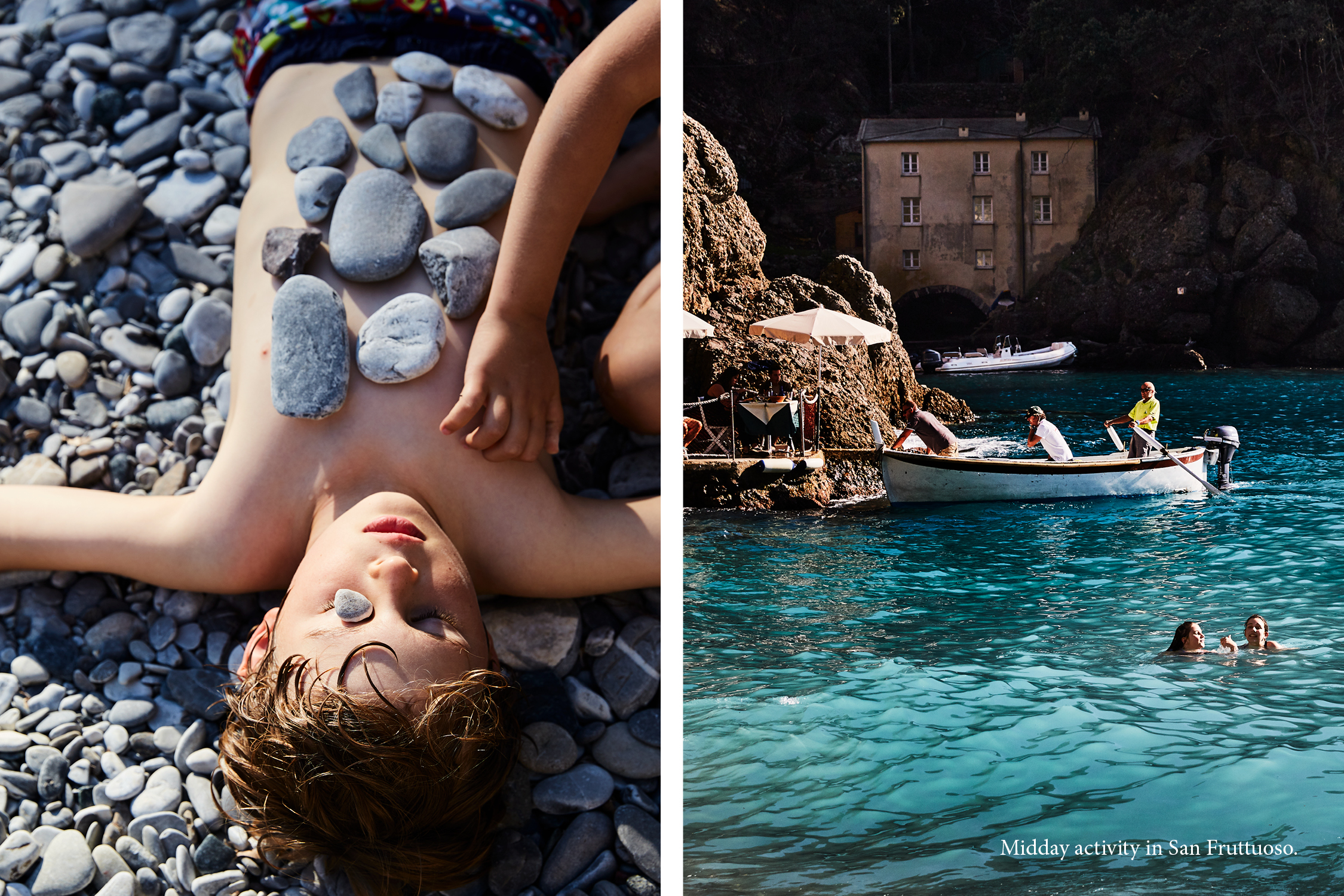
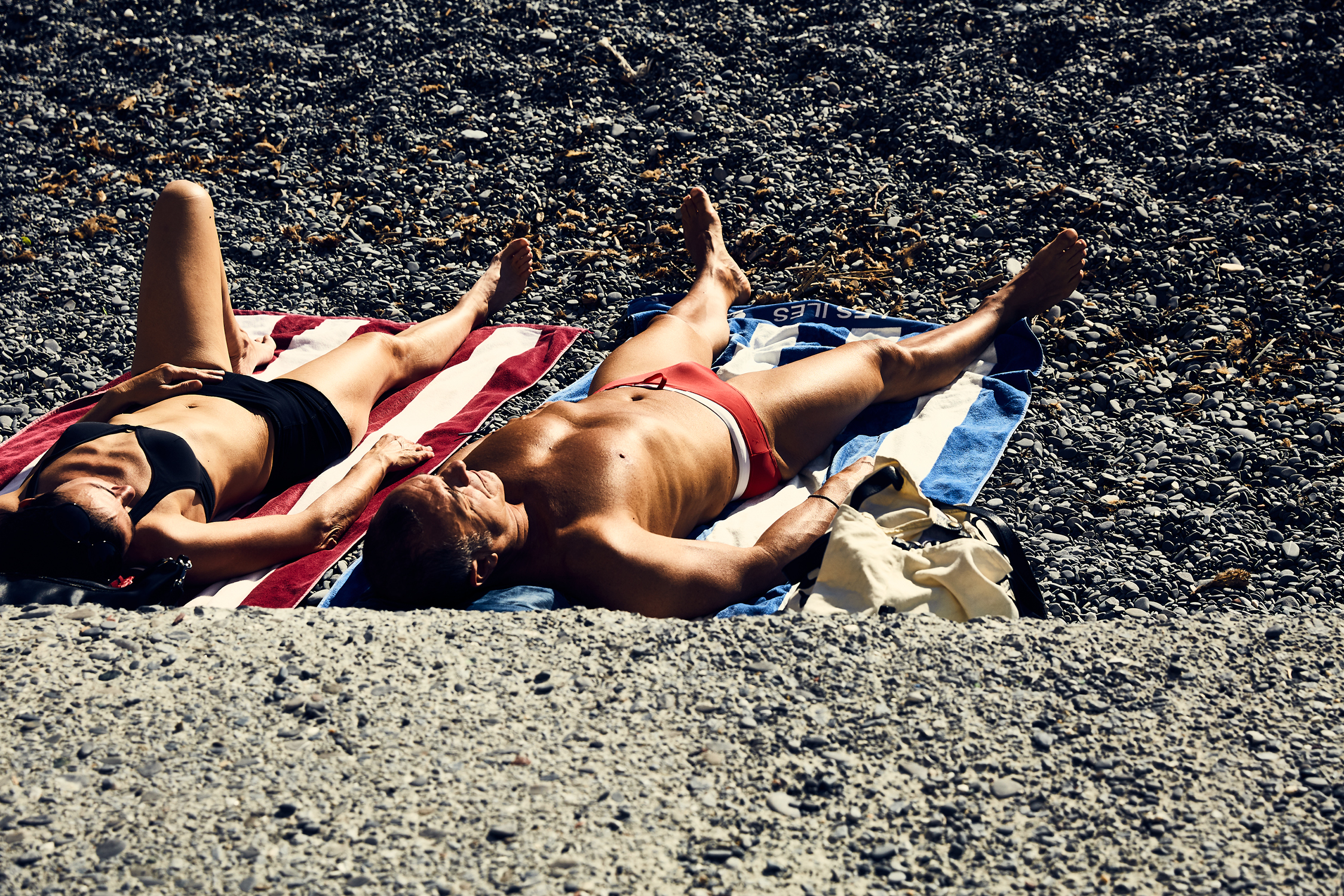
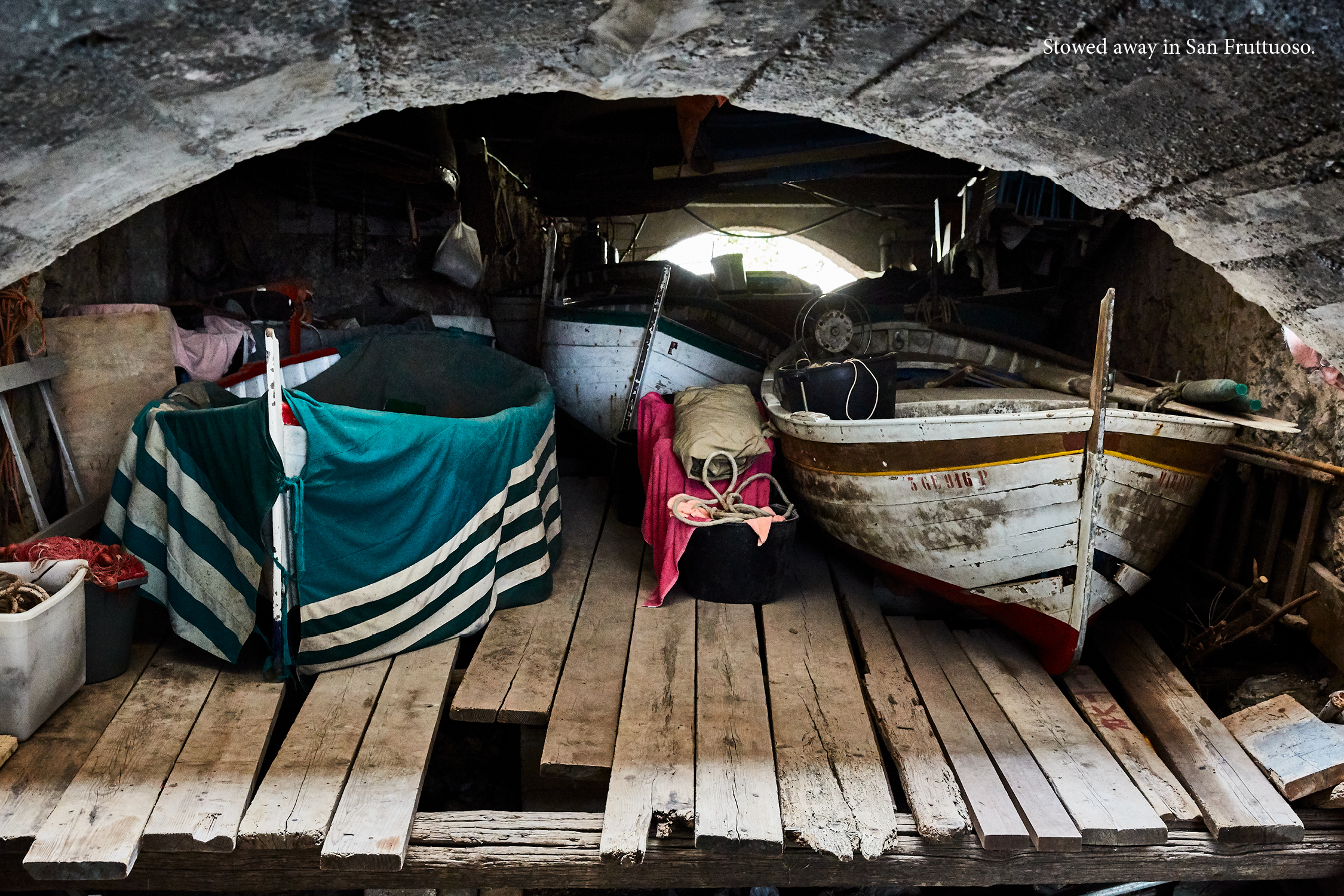
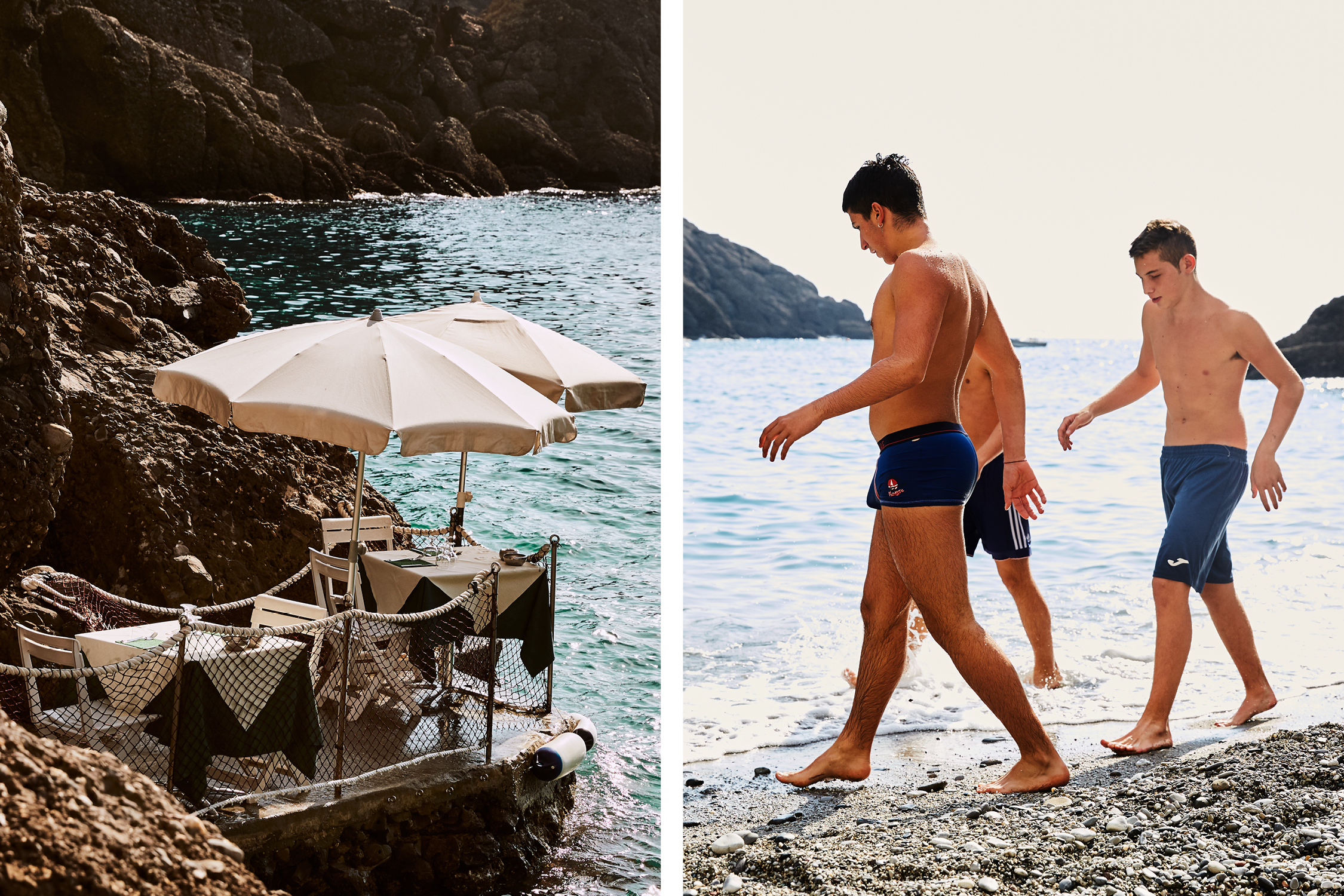

On my last day hiking to San Fruttuosso I decided to take the long way, around the other side of the mountain, the wet side, through a lush forest winding in the canopy of coastal pines. The weather had turned. It was raining a soft misty rain and the wind was blowing. A fog started to settle in. The hike seemed extra long today, more ups and downs, and I didn’t have a great sense of where I was. As I descended what I hoped was the last descent into San Fruttuosso, I passed a guided walking tour heading in the direction of Camogli. One of the guides informed me that as the seas were too high today there were no ferries running back to Camogli. My heart sank just a little. I really did not have the energy to turn around and walk back another 4 hours but braced myself for the inevitable, deciding I would continue nonetheless to San Fruttuosso and at least fill up on coffee before walking back. The town was deserted when I got there, which made sense since most people don’t actually walk here, they take the ferry to and fro. Getting my cappuccino, I asked the woman at the restaurant about the ferry situation. She confirmed that indeed it was not running, but that she and her co-workers were hiring a guy in an inflatable outboard to take them back to Camogli. And there was room for one more. What luck!

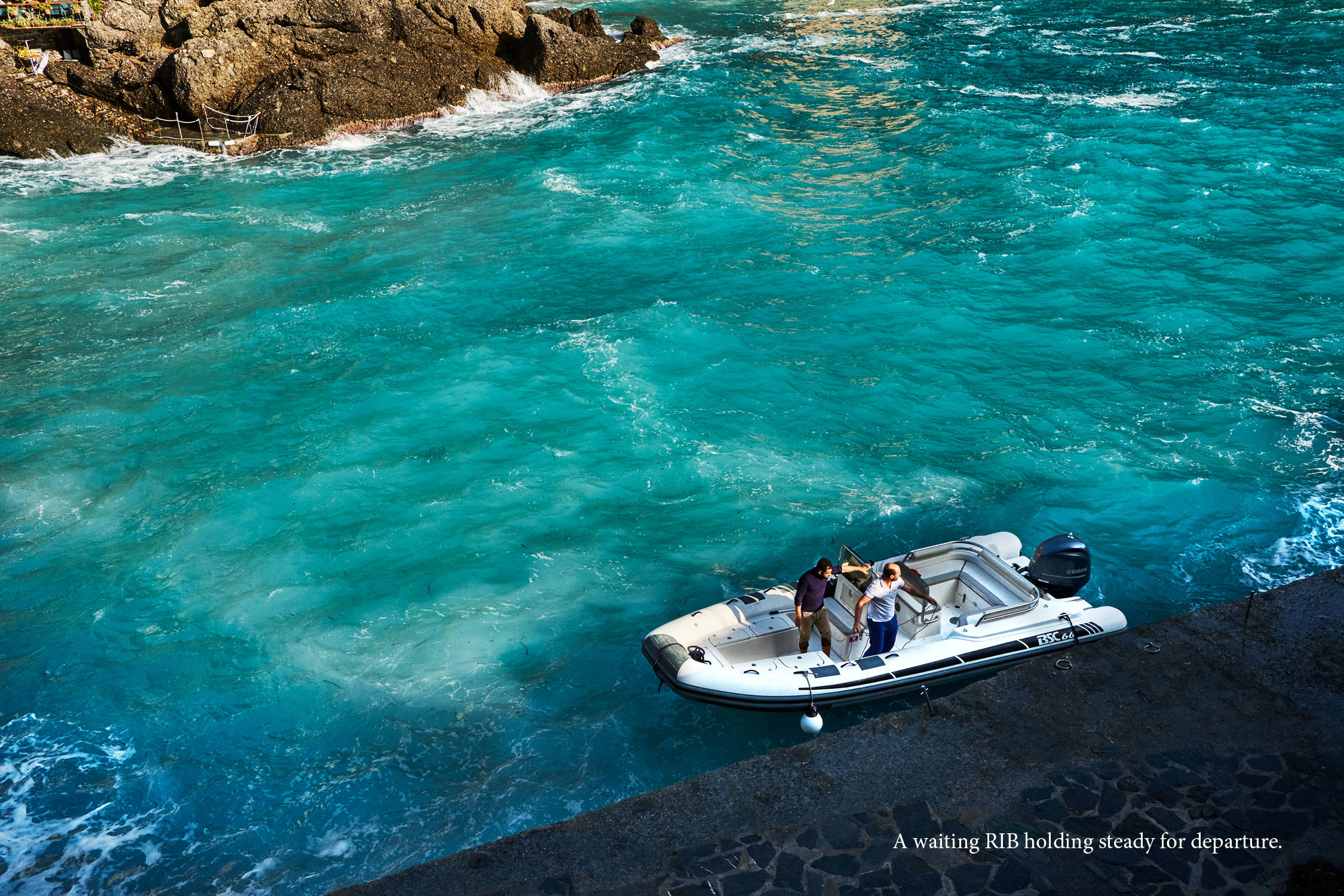
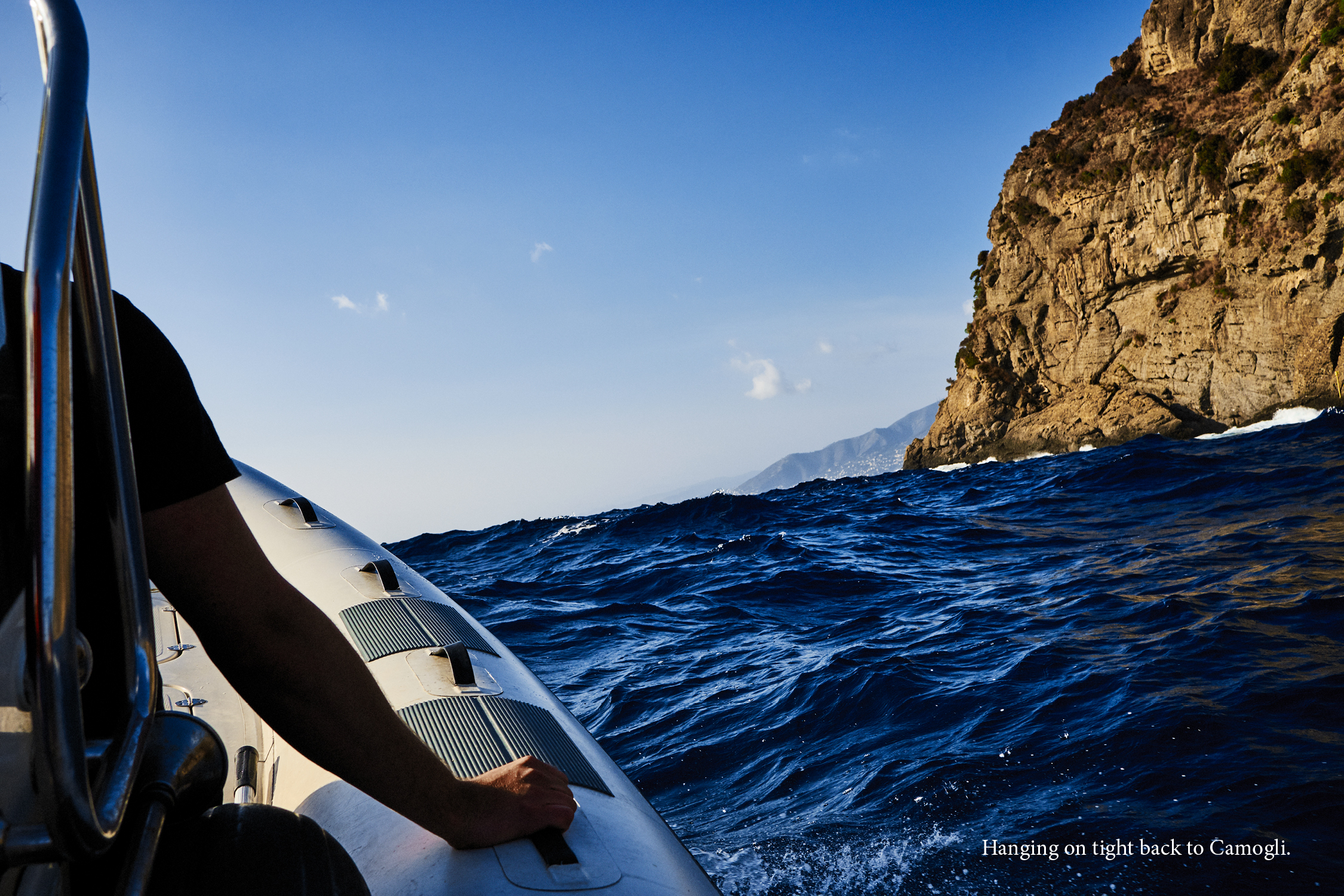
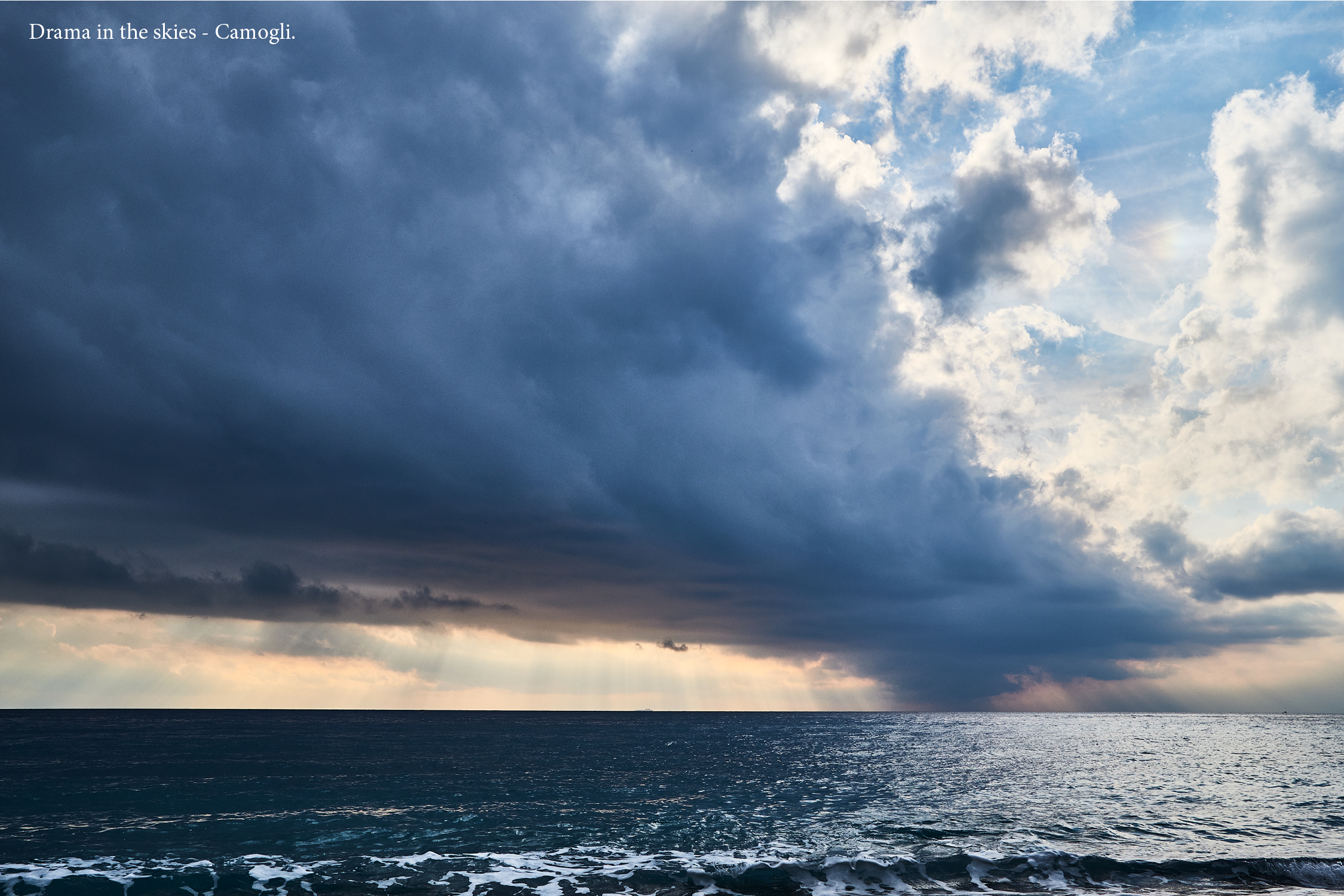
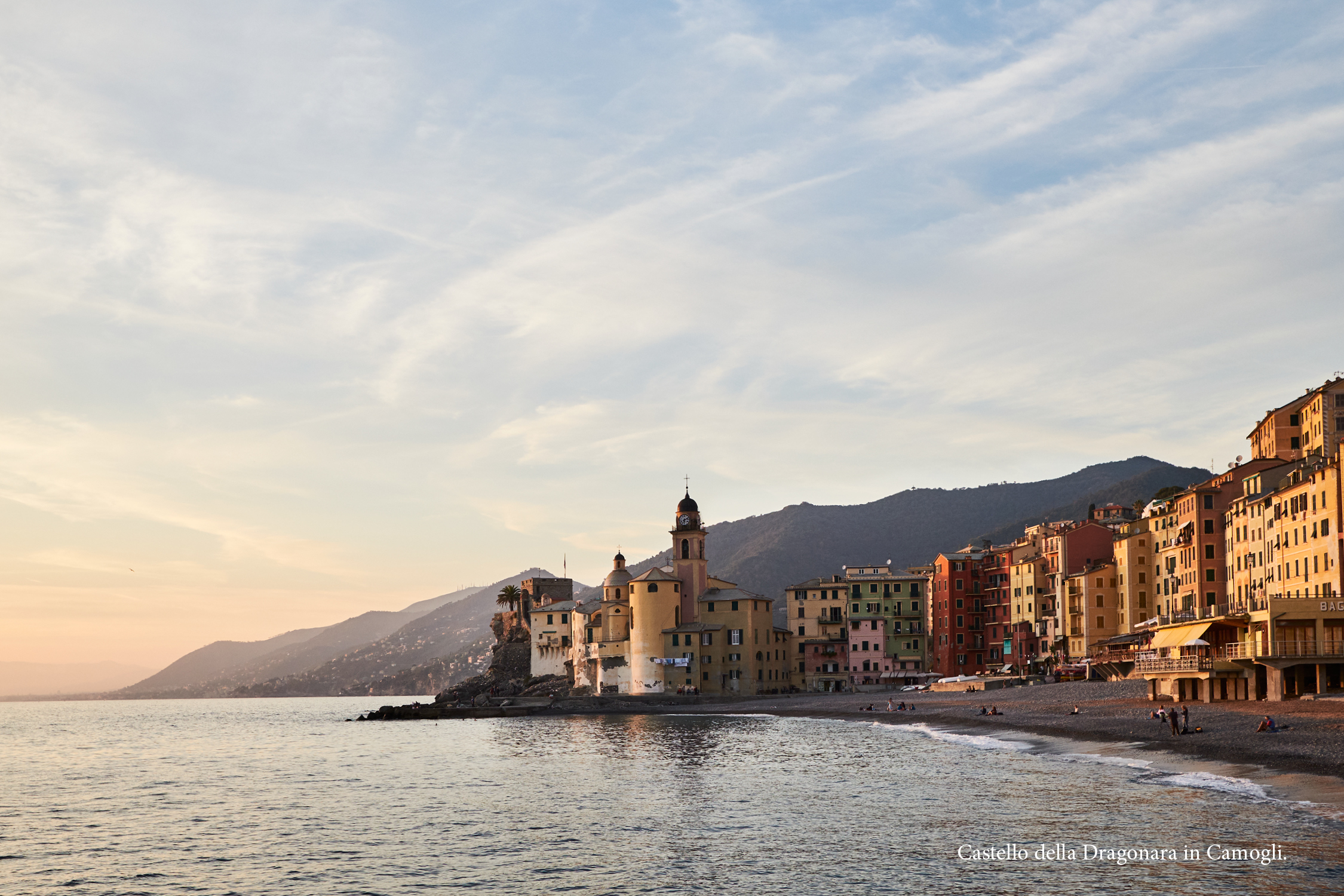
The sea was so high that it took the boat multiple tries to land. The waves were crashing onshore not as a break but as a swell that ran out of sea, washing over the dock with a foot or more of water. There was nowhere for the outboard to tie off and the swell kept making the captain miss the landing. Standing on the flooded dock I braced myself so as not to fall over and held out my hand as he threw me a line. It took a few tries, but I finally managed to grab it and was able to hold on and pull the Zodiac in, as the women from the snack bar boarded with the help of the captain’s outstretched hand. The last to board I barely made it on as another swell lifted the boat up and away from the dock, the captain literally grabbing my arm in the nick of time. I sat on the gunnel and held on as the boat pushed into the oncoming waves, floating over them, away from the tiny seaside town. The sky began to clear opening into a deep cerulean blue to match the water. Heading back to Camogli, face against the wind, getting sprayed with warm Mediterranean waters, I thought, OK this is exactly why I travel, for times like these.
BEST PLACEs TO STAY IN CAMOGLI
- HOTELS -
Hotel Cenobio Dei Dogi (the only 4 Star Hotel in Camogli)
- AIRBNB-
A Villa “Classico”
A Villa For La Famiglia
Pretty in Pink
The Sea Lover
Modern Sensibility
BEST PLACES TO EAT IN CAMOGLI
RISTORANTE CUCU
REVELLO
PASTA PASTICCERIA TOSSINI
PASTA FRESCA FIORELLA
CAFFE DEL TEATRO
O MAGAZIN DI CAMOGLI
SA
OSTAIA DA O SIGU

Words and photographs by Colin Clark - Contributor to TAKE ME AWAY
Copyright © 2018 Colin Clark, All Rights Reserved
